TheIrrawaddy



• As a respected news magazine with more than 20 years experience ...
If you are interested in promoting your business with us, please call our marketing manager Chan Myae Aung at 09 4301 2797. He can also be reached at Chan.Myae.Aung@irrawaddy.org.
• As a news agency that carries up-todate information about Myanmar and Asia ...


• As a website with more than 5 million monthly readers worldwide …
You can trust The Irrawaddy and advertise your business on our Myanmar- and English-language websites, and in The Irrawaddy monthly magazine.
The first 10 contacts will be given a 70 % discount and free delivery of the magazine.
Advertise with us and your business will be SUCCESSFUL!

e DIto R-IN-C hIeF Aung Zaw MANAG

The Irrawaddy magazine covers Myanmar, its neighbors and Southeast Asia. The magazine is published by Irrawaddy Publishing Group (IPG) which was established by Myanmar journalists living in exile in 1993.
e DIto R (e nglish e dition): Kyaw Zwa Moe
CoPY De SK: Neil Lawrence; Paul Vrieze; Samantha Michaels
CoNt RIBU to RS to this issue: Aung Zaw; Igor Blazevic; jacques Maudy; Kyaw Zwa Moe; Kyaw Phyo Tha; Marwaan Macan-Markar; Paul Vrieze; Samantha Michaels; Saw Yan Naing; Steve Tickner; Thitinan Pongsudhirak; William Boot
Photo GRAPhe RS: j Paing; Steve Tickner
LAYoUt D e SIGN e R: Banjong Banriankit
Re GI o NAL heADQUAR te RS MAILING ADDR e SS: The Irrawaddy, P.O. Box 242, CMU Post Office, Chiang Mai 50200, Thailand.
YANGoN B URe AU : No. 197, 2nd Floor, 32nd Street (Upper Block), Pabedan Township, Yangon, Myanmar. teL: 01 388521, 01 389762
e MAIL: editors@irrawaddy.org
SALe S&ADV eRtISING: advertising@irrawaddy.org
PRINte R: Chotana Printing (Chiang Mai, Thailand)
PUBLIShe R: Thaung Win (Temp-1728)
14 | diversity: Among the Moken, the Sea Gypsies of Myeik

A unique culture that has survived for millennia is rapidly vanishing, as the Moken people are forced to leave the sea for life on the land
20 | border: An Open Secret, an Illicit Trade without end Myanmar is at the heart of a flourishing illicit drug industry that is poisoning societies around the region and beyond
24 | regional: Thailand’s Turn for Peace in Troubled South Offers Little hope, So Far


Bangkok is taking a new tack in its efforts to end a nearly decade-old insurgency in Thailand’s far south, but violence in the predominantly Muslim region rages on
|




Though the ruling coalition managed to retain its hold on power, its leader faces tough questions about the direction of the country
30 | cover A radically Different Dhamma
While traditional Buddhism urges its followers to seek peace of mind, a new brand of Buddhist nationalism strives to stir up anti-Muslim passions
36 | cover ‘It’s naïve to say 969 is behind the unrest’

An interview with Myanan Sayadaw U Thaddhamma

38 | cover ‘Monks are being used’
An interview with U Pantavunsa
40 | nationalism: The Vicious Cycle of extreme Nationalism
As the experience of the former Yugoslavia attests, the rise of rabid nationalism can subvert an emerging democracy in dangerous—and devastating—ways
|








One of the world’s largest automakers hopes to make strides in a market long dominated by a military conglomerate’s used-car imports


48 |
business: Chinese State, US Billionaire, Irish Tycoon in Telecoms Bid
P-20
P-30
UZaw Zaw, the founder of the Max Myanmar Group and chairman of the Myanmar Football Federation, may be Myanmar’s most socially conscious “crony.” As a longtime target of Western sanctions, he laments that his business ambitions have been hampered by his close ties to Myanmar’s former military rulers. Now, however, he seeks to redeem himself by playing an active role in rebuilding the country’s economy.
On April 30, President U Thein Sein recognized U Zaw Zaw’s contributions by giving him the State excellence Award, both for his entrepreneurship and for “dutifully” paying his taxes—something the leading businessman says is a priority for all of his companies.
In this interview with The Irrawaddy reporter htet Naing Zaw, he discusses his reputation as a “crony” and his future ambitions for both himself and his country. To help raise Myanmar’s standing in the world, he says, he is willing to work “together with the state government, the opposition and the people.”
You used to say that even if you are a so-called ‘crony,’ you want to be a good one. Why is that?
I am a Myanmar and a native of this country. I have never betrayed my country. I love it and want it to be honored. I do business and pay taxes. At the same time, I take care of my staff as I would my children and carry out CSr [corporate social responsibility] for them. Nowadays, I have become a political victim and been called strange names. I don’t have any comment on that.
My belief is that I will do my best for my country no matter how much I am criticized. I will continue doing my business honestly. I will also help young people and nurture them to be brilliant.
What is the value of your assets right now?
A valuation on my assets should be
carried out first in order to answer this exactly. There are international valuation companies that assess us. What I mean is that I bought a house for 100 million kyat [US $125,000] before, but it may be worth a billion kyat now. So I can tell you exactly only after the valuation.
In 1990, you went to work in Japan. You were an ordinary worker then. How did you manage in the last 20 years to build this life for yourself from those origins?
In 1988, I was studying my final year at Yangon University, majoring in mathematics. I am very careful with my time. I strove full time with the intelligence and prudence I gained, thanks to my teachers and parents, from primary school to graduation. I have always tried to achieve good results. Whatever I do, I want to make
it happen and finish it. I also want to make it successful.
Another thing is that I have many friends and I don’t find it difficult to tolerate others. Besides that, I am honest, have never cheated anyone in my life even for a penny, and have never committed any crime. To be frank, I am where I am now because I have been striving full time and [this is the] cause and effect of what I’ve done.
even though a 20-year period is not that long, in reality it is about a quarter or one-third of a lifetime. In some countries, there are many people who have become billionaires within five to 10 years. I am rich to a certain extent in Myanmar, but I am not competing with anyone in my country. It is very shameful if we compare ourselves with other countries. Our wealth is in fact quite small.
I want to compete with people in other countries in our education, social, health and economic sectors. Because these are my desired benchmarks, I have found that we haven’t reached any status and I am always ready to keep trying to achieve a better status for my country.
You have established the Ayeyarwady Foundation, which donates to various philanthropic causes. But would it be fair to view such activities—and your commitment to CSR—as equally beneficial to you and your businesses as a promotional vehicle?
The word CSr arrived in Myanmar not long ago. If you look at my donations, they began when I was young. When I was 12, I offered coats of whitewash over stupas in my hometown. I participated in all social occasions of joy or grief there. Likewise, the Yegyi Township Association, a social organization for students from the same place, was founded only after I came to study at Yangon University.
Then, I went to japan to work. I worked there for about 20 hours a day. When I came back to Myanmar, I bought a fire truck and donated it. During that time, I didn’t know about CSr or know the word crony, which I and others have
been labeled. I just did it because I was told by my teachers and parents that as a Myanmar Buddhist, I should do such activities out of pure desire from my heart. If you ask me why I donate, I would say that helping needy people is a good thing and I will continue to assist them.
You have said that your assets will be donated when you die. Where will you donate them?
According to Lord Buddha’s teaching, your assets won’t follow you after your death but kamma [the result or
consequences of what you have done] will. I make donations and [pursue] merit because I want to take the consequences along with me. I bestow well-wishes and goodwill on others. Mainly bearing in mind Buddha’s teachings, I have decided to donate as much as I can before I die.
You have supported opposition leader Daw Aung San Suu Kyi and prominent democracy activist U Min Ko Naing. Some people think you are trying to court Daw Aung San Suu Kyi because you want your name to be removed from
international sanctions lists. Any comment on that?
Why do we need to contend with each other, which will eventually lead to organizational schisms, in this fragile country? We have many things to do to re-establish it. Our country is still really poor and need is everywhere. Under such circumstances, if we go in opposite directions, we won’t reach a good destination. I want to tell everyone that I want to establish our country together with the state government, the opposition and the people. I only have this desire in mind.
As a successful businessman, do you have any plans to enter the political arena?
I currently don’t have any plans for that. I want to create job opportunities for our people. They can survive properly only if they individually have a good income. So, apart from me, many young businessmen should emerge in Myanmar. Youths should also be given jobs as foreign investment comes into the country.

But at the moment, many Myanmars have to go to other countries to find work. That doesn’t matter if they are working in those countries as educated persons or scholars. Unfortunately, since we can’t provide work here, they have to go abroad for lowly jobs. Personally, I want to create jobs for them in this country so they can work here. I have enough for my life’s security and can survive well. What I am striving for now is to compete with other countries, since I always have a competitive mind.
Do you believe in the legitimacy of the ongoing political reforms in Myanmar led by President U Thein Sein? Do you think this democratic transition will be successful?
I only have positive thinking about it. Compare our country’s situation two years ago and now! People can’t just say their wishes. It takes time for something to happen. real effort is also needed. All tasks carried out under the current reform process are very good. For me, I only hope for the positive.
Zaw Zaw, chairman of Max Myanmar Group—Malaysian opposition leader Anwar Ibrahim, at a rally held soon after the ruling party won reelection on May 5, 2013

—Aung Thaung, a senior member of the ruling Union solidarity and Development Party, on plans to cooperate with the opppostion National League for Democracy on amending Myanmar’s 2008 Constitution

“It is widely assumed that corruption is rampant in the sector and that much of the country’s resource revenues are diverted to the foreign bank accounts of a few government officials.”
—Revenue Watch Institute, in a report on transparency in Myanmar’s natural sector, which it ranked last in the world

—Tibetan spiritual leader the Dalai Lama, calling on Buddhists in Myanmar to refrain from violence against Muslims

“This is merely the beginning of the battle between the people and an illegitimate, corrupt and arrogant government.”
“If from one corner of your mind, some emotion makes you want to hit, or want to kill, then please remember Buddha’s faith. We are followers of Buddha.”
“Some parts of the Constitution may be amended by the NLD and some may not. We are going to work together.”
Cartoons
Features
The Irrawaddy website receives more than 80 million hits each month. In 2010 we had more than 5.2 million website visits—averaging 650,000 visits and 2.2 million pageviews per month. More than 180,000 unique visitors from 200 countries worldwide access our website every month. Visits from readers inside Myanmar have tripled since the early 2012.
Indonesia’s government announced on May 3 that it had foiled an alleged
plot by Islamists to bomb the Myanmar e mbassy in j akarta. h ours later,
former residence might be torn down by investors, but plans for renovation ultimately won out. Katha served as the inspiration for the fictional district of Kyauktada in Orwell’s 1934 novel “Burmese Days.”
hundreds of hardline Muslims gathered outside the mission to call for jihad in Myanmar over the country’s alleged persecution of Muslims. Two suspected militants were arrested the night before, and five homemade bombs were seized from a backpack they were carrying after authorities were tipped off about their whereabouts. Their interrogation led to a rented house where other explosive materials were found. A week later, Indonesia’s elite antiterrorism unit killed 7 other militants suspected of involvement in the plot.
registration and distribution of publications considered 11 applicants. Private dailies started publishing in Burma in April after a 45-year ban.
Number of IDPs in Myanmar Rises to 450,000: Report

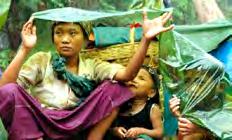
having signed ceasefires with Naypyitaw, there are some 250,000 protracted IDPs.
Dozens Dead after heavy Rains Lash Southern Shan State
Torrential downpours in southern Shan state caused a goldmine in Kalaw Township to collapse on May 2, killing at least 36 workers. Col. Zaw Win, a subcontractor at the mine in Shwe Min Phone village, told The Irrawaddy that another eight people were still missing several days after the incident. h eavy rainfall had also washed away around 170 buildings, including two schools, according to police reports. The mine, owned by Geo Asia Industry and Mining Company, employs more than 10,000 workers, around half of whom left the area after the disaster.
A house once lived in by British novelist George Orwell is set to be restored and reopened to attract tourists to the remote Sagaing r egion town of Katha. The long-neglected two-story building was home to Orwell when he served as an Indian Civil Service officer in Myanmar in the 1920s, during the era of British colonial rule, and is a popular destination for visitors who take cruises on the Ayeyarwady r iver, according to tour operators. In February, news spread that Orwell’s

Myanmar’s government gave 10 more private daily publications permission to hit the newsstands, state media reported on May 1, bumping the total number of daily private papers in the country to 24. The 10 new dailies include National Time Daily, Daily e leven News, Myanma Freedom Daily, The Nagani Daily, Dana Business Daily, Warazein Daily, Newswatch Daily, The Pyi Myanmar Daily, Myanmar Post Daily and the International herald Tribune, according to the state-run New Light of Myanmar, which said the government’s committee for
Internal conflict and communal violence displaced a further 166,000 people in Myanmar in 2012, bringing the total number of internally displaced persons (IDPs) in the country to “at least 450,000 people,” according to a global report released by the Internal Displaced Monitoring Centre. The report said inter-communal violence in rakhine State displaced 125,000 people, while the ethnic conflict in Kachin State, which escalated in late 2012, caused more than 75,000 civilians to flee. In southeastern Myanmar, where Kayin and Shan rebels groups have skirmished with government forces despite
The district court of Meikhtila filed murder charges on May 6 against six Muslim men accused of killing a monk in the central Myanmar town in March. A lawyer for one of the men said that his client, Myat Ko Ko, had confessed to killing the Buddhist monk, U Thawbita, on March 20, amid communal riots sparked by an incident earlier in the day at a Muslim-owned gold shop. Meanwhile, another outbreak of communal violence in Okkan Township, Bago region, in late April led to the arrest of 39 people accused of destroying
Muslim-owned homes and businesses, while 10 ethnic r akhine Buddhists were sentenced to between nine months and three years’ imprisonment in connection with communal violence in rakhine State last year.
More than 2,000 ethnic Shan civilians have fled their villages since fighting between Myanmar government troops and the Shan State Army-South (SSA-South) broke out in early May. Despite a ceasefire between the two sides, the clashes have intensified, forcing many to seek shelter in the town of Nam Kham and across the border in China. The Shan rebels accused the Myanmar army of breaking the ceasefire with a fresh offensive in Naw Kham Township, a mountainous area near the
Chinese border. Meanwhile, on May 15, the state-run newspaper The New Light of Myanmar reported that two people were killed when SSA-South troops when opened fire at the staterun Myanma Oil and Gas e nterprise compound in Nam Kham.
ss A- s outh chief Lt-Gen yawd s erk shakes hands with Myanmar’s Deputy Commanderin-Chief Gen Soe Win after the signing of a peace deal in May 2012.
A leading reformist minister who played a key role in promoting Myanmar’s new
foreign investment law has left his post as head of the government’s investment commission, The Financial Times reported on May 8. U Soe Thane, a President’s Office minister with close ties to President U Thein Sein, stepped down as chairman of the Myanmar Investment Commission, which approves foreign investment projects, and will be replaced by Finance Minister U Win Shein, following criticism among conservative politicians opposed to the quick pace of reform. U Soe Thane will continue overseeing economic affairs in his ministerial role.
Two passengers were injured on May 16 when a Myanmar Airways plane landing in Monghsat, northern Shan State, shot past the end of

President U Thein Sein became the first Myanmar head of state in nearly 50 years to visit his US counterpart at the White h ouse on May 20. During the visit, US President Barack Obama broke with official policy to refer to his guest’s home country as Myanmar, instead of Burma, as it is still designated in the United States. Last November, Mr Obama became the first sitting US president to visit the country. The trip aimed to end Myanmar’s decades of diplomatic isolation and reward its shift from authoritarian rule. During U Thein Sein’s visit, he and Mr Obama
discussed Myanmar’s democratic transition, communal and ethnic
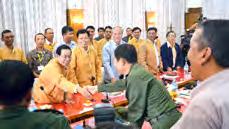
tensions and providing economic opportunity for Myanmar’s people.
the runway due to a brake failure. The Fokker plane was carrying 55 passengers when it went 200 meters off the runway before hitting a fence and stopping. A wing and a wheel on the aircraft were damaged in the accident, and two passengers suffered broken arms. The flight had departed from h eho, also in Shan State, where three people were killed on Christmas Day 2012 when an Air Bagan flight crash-landed on a local road. One of the victims of the crash was a motorcyclist who was hit by the plane as it descended in heavy fog.
A boat carrying about 100 rohingya Muslims capsized off Myanmar’s west coast on May 13, with as many as 50 feared drowned at the start of a mass evacuation from low-lying regions ahead of Cyclone Mahasen, UN officials said. The boat struck rocks off Pauktaw Township in rakhine State, according to the UN Office for the Coordination of humanitarian Affairs. Nearly 20,000 rohingya had been living in makeshift camps in Pauktaw, including about 12,000 in flood-prone areas, since an outbreak of violence between ethnic r akhine Buddhists and r ohingya Muslims last year. The cyclone, which made landfall on May 16, largely spared the rakhine coast but claimed at least 18 lives in Myanmar, Bangladesh and Sri Lanka.
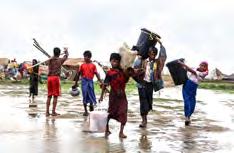 Myanmar p resident U t hein s ein sits with U s p resident Barack Obama in the Oval Office at the White House on May 20, 2013.
Rohingyas evacuate a temporary camp near s ittwe, capital of Rakhine s tate, as Cyclone Mahasen approaches.
Photo: t he RRawaddy
Photo: Reute Rs
Myanmar p resident U t hein s ein sits with U s p resident Barack Obama in the Oval Office at the White House on May 20, 2013.
Rohingyas evacuate a temporary camp near s ittwe, capital of Rakhine s tate, as Cyclone Mahasen approaches.
Photo: t he RRawaddy
Photo: Reute Rs
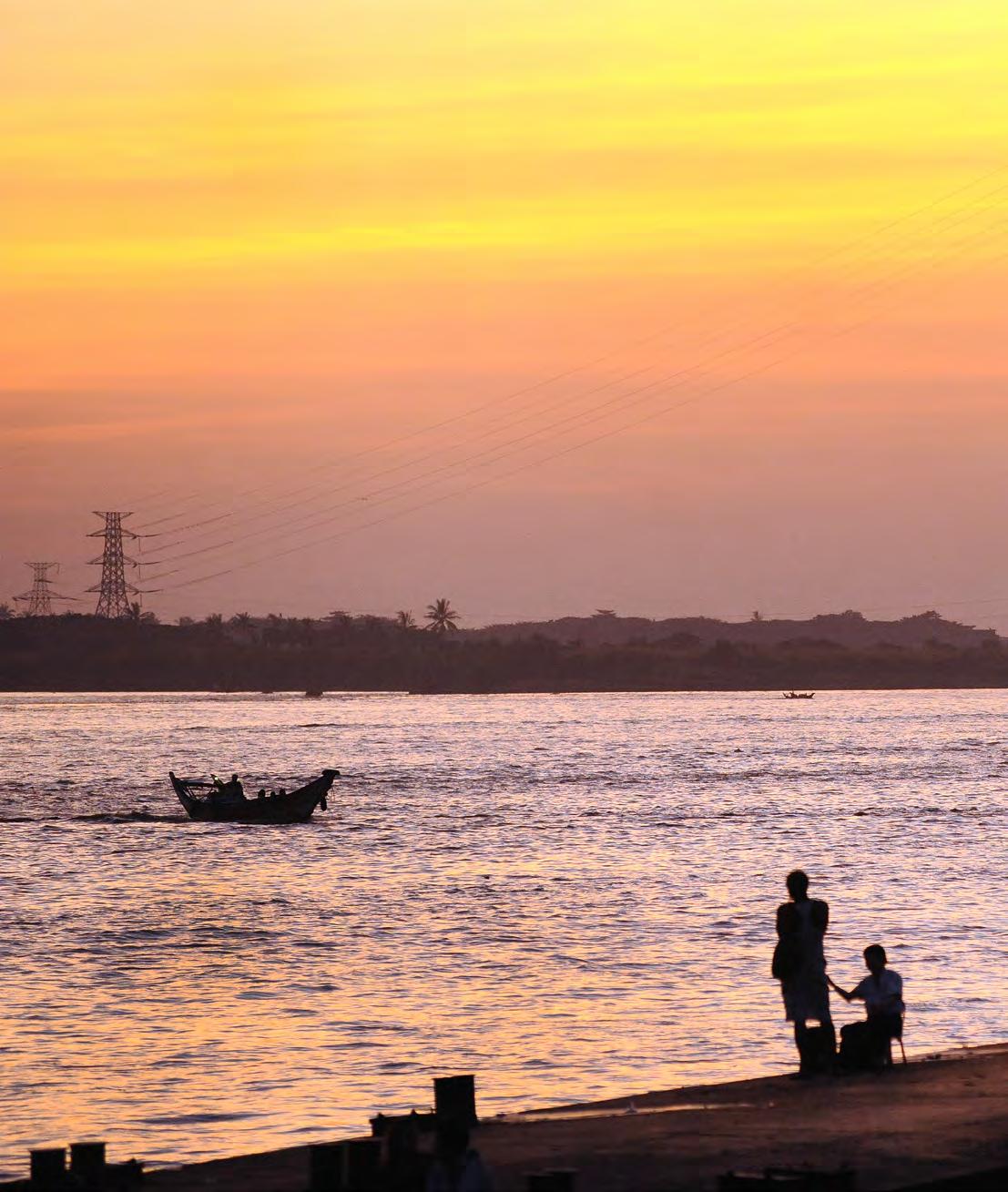
High voltage power lines stretch across the yangon River to deliver an inadequate and irregular power supply to a city where demand is growing daily. Much to the frustration of the city’s residents, power outages during the hot summer months have been even more frequent than in previous years.


When Myanmar made the transition to quasicivilian rule two years ago, most observers were skeptical. Would the new militarybacked government really bring reform, they asked, or would it just be the same old regime in a slightly different guise?
Well, the government of President U Thein Sein has proven all the doubters wrong. The leopard has not only changed its spots—it has also sprouted feathers and learned how to quack. Indeed, it is getting more difficult with each passing day to know what manner of beast this new government is, and even harder to know what to make of almost everyone in any way related to Myanmar’s “great transition.”
By AUNG ZAW and NEIL LAWRENCEThe most dramatic change, of course, has been in the image of the president himself. Formerly the figurehead prime minister of a reviled military regime, he has gone from being seen as a mere puppet of his higherups to becoming, at least in the eyes of some, a great agent of change.
The finishing touch to U Thein Sein’s extreme makeover came on April 22, when he was awarded the International Crisis Group’s “In Pursuit of Peace Award.” And so, after decades as one of Myanmar’s reptilian men in green, it seems he is now a fullfledged dove, fit to receive invitations from Washington and other Western capitals.
But U Thein Sein is not alone in the shape-shifting game. U Khin Nyunt, another once-feared former general who fell from grace nearly a decade ago, was back in the news again in May when it was revealed that he had opened an art gallery and coffee shop in his residential compound.
Think about this for a moment: The ex-Military Intelligence chief, who almost single-handedly created Myanmar’s police state, is now in the business of selling paintings and serving lattes. Where else but in the magical land of the new Myanmar could a man whose name once sent shivers up people’s spines pass himself off as a
Reform has done little to change the lives of ordinary Myanmar citizens, but it has altered some of the country’s key figures almost beyond recognition
genteel barista and patron of the arts?
But the vogue for abrupt career shifts is not confined to Myanmar’s former military strongmen; even foreigners have been affected by the euphoria over the opening of Southeast Asia’s last frontier.
In February, Kurt Campbell, the former US secretary of state for east Asian and Pacific affairs, packed in his academic and diplomatic career to found The Asia Group, LLC, an investment group that offers advice on how to make a bundle in the world’s fastest growing region. Among his first assignments: lobbying for an American consortium keen to win a contract to upgrade Yangon’s international airport.

Writing about Myanmar’s potential for the Financial Times blog, Mr Campbell could barely contain himself: “It’s damn exciting,” wrote the man who at one time acted as the chief negotiator between Myanmar’s military regime and the democratic opposition.
For the most part, however, Myanmarmania has had its greatest transformative effect on the country’s citizens, particularly those once held up as paragons of social and political virtue.
The latest wave of anti-Muslim violence that began in Meiktila in March has claimed many casualties, not the least being the reputation of Myanmar’s monks. It was not so long ago that the world watched in awe as Buddhist monks resisted the military’s might armed with nothing more than the Metta Sutta, the Buddha’s discourse on loving-kindness. These days, however, they are more likely to be seen as ringleaders of nasty pogroms that aim to rid cities, towns and villages of their
Muslim inhabitants.
The metamorphosis of opposition leader Daw Aung San Suu Kyi has been even more shocking for many, especially those who saw her as the sainted savior of her nation. Once faulted for being too rigidly principled, her support for the controversial Letpadaung copper mine, a Chinese-backed project opposed by local villagers, has recast her as an über-pragmatist, prepared to do anything that will help pave the way to power.
The greatest hurdle to the Nobel Peace Prize winner’s quest for the ultimate prize—Myanmar’s
holds 25 percent of the seats, giving it the ultimate say in what stays and what changes.
But this hasn’t prevented Daw Aung San Suu Kyi from seeking allies in her bid to undo the former junta’s carefully laid plans to prevent her from becoming Myanmar’s leader after the next election in 2015. But to stand any chance of success, she will need the backing of the ruling party, the Union Solidarity and Development Party (USDP), which holds the lion’s share of seats thanks to the rigged 2010 election. Not so long ago, any cooperation between the USDP and the National League for Democracy (NLD) leader would have been unthinkable. After all, 10 years ago, thugs from the Union Solidarity and Development Association, an earlier incarnation of the USDP, carried out one of the worst political massacres in Myanmar’s modern history, slaughtering scores of NLD supporters in an attack on Daw Aung San Suu Kyi’s entourage near Depayin, Sagaing r egion, on May 30, 2003.
But none of that seems to matter today.
presidency—is the 2008 Constitution, which was designed to keep her out of the country’s highest office by banning anyone with family ties to any other nation from serving as chief executive. Changing this—or any other—provision in the national charter is virtually impossible, because of a requirement that all amendments must have more than 75-percent support in Parliament. The catch, of course, is that the military
“If they really want to change the Constitution, there’s no reason not to fully co-operate with them. All together we can co-operate. The USDP made a proposal to organize the committee to amend the Constitution. We did support that proposal,” said the opposition leader who would be president.
These are strange days, indeed. While there’s no telling how all of this will turn out, one thing seems sure: Whatever you think you know about Myanmar today will almost certainly be proven untrue tomorrow.
Photo: Reute Rs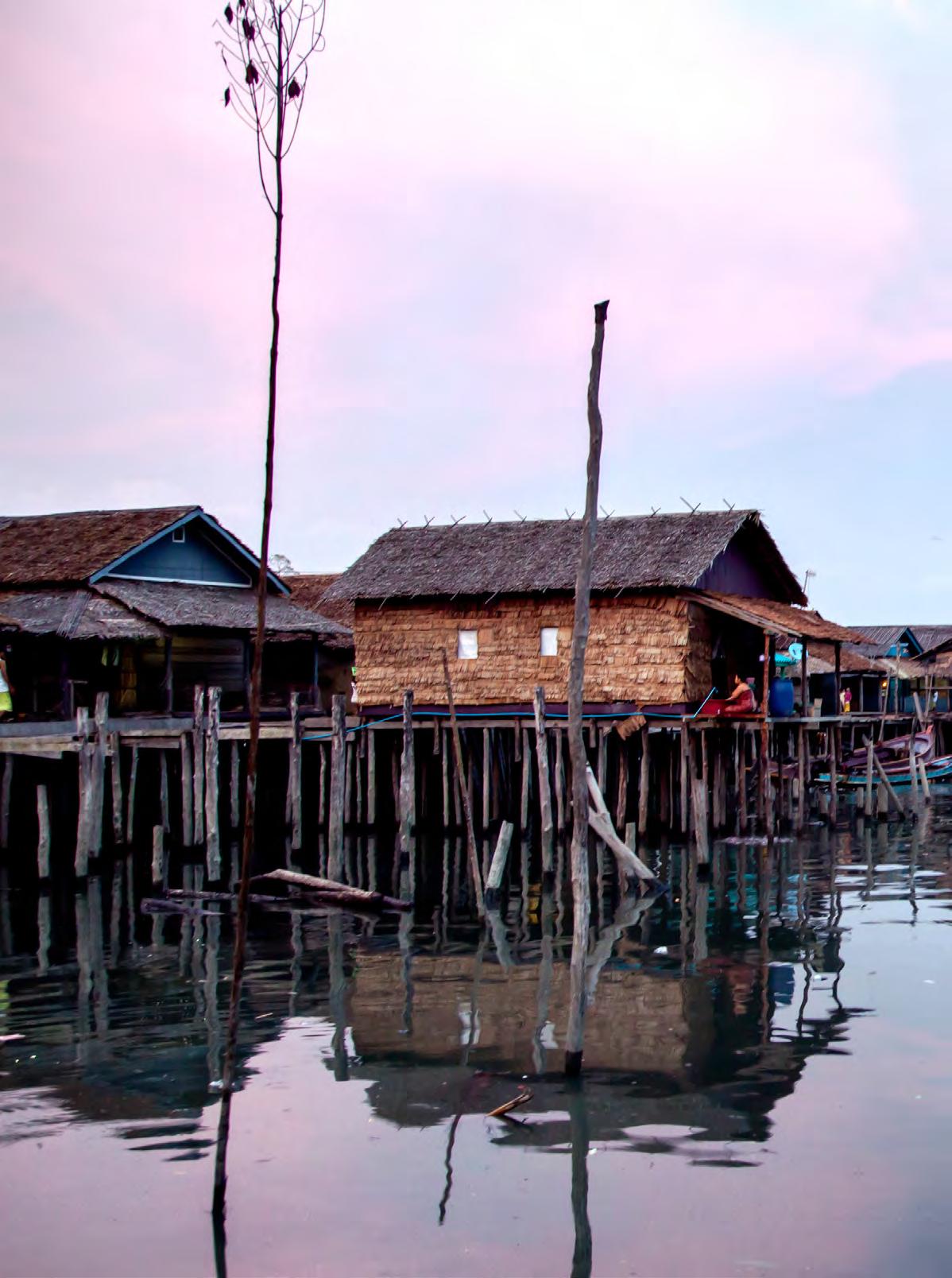
A unique culture that has survived for millennia is rapidly vanishing, as the Moken people are forced to leave the sea for life on the land
By JACQUES MAUDYsunset at Dae Kyaw village on Dormel island lights the sky in pink and blue hues. The village is lifted five to seven meters from the seabed on wooden platforms to allow the influx of tidal waters.


It’s 3 am, and I’m sitting on a freight boat off the shore of an island in the Myeik Archipelago as the crew sends signals to shore with a flashlight. Around five hours earlier, my guide and friend U Soe Khai (not his real name) smuggled me aboard, avoiding the watchful gaze of immigration officials at the Myeik jetty. When I ask him why we had to do this, since my media permit gave me unrestricted access to the islands, he says: “This way immigration has no eyes and no ears.”
So began my six-day journey in search of the Moken, the elusive sea gypsies of Myanmar’s far south. The island, I later learned, is called Kristiang, and it is one of some 800 unspoiled islands extending from the town of Myeik all the way to Myanmar’s southernmost point, Kawthaung. The Moken, or Selung, as they are officially known, have lived among these islands and others farther to the south off the coast of Thailand for 3,500 years.
Despite their long presence in this area, however, the Moken are rapidly losing their way of life under pressure from the environmental impact of fishing and logging. To survive, they have had to adapt to modern life while still clinging to what’s left of their culture.
For most of the year, the Moken live at sea, on boats known as kabang that are carved from a single tree. Their entire lives revolve around these handhewn vessels, which are not only a means of transportation, but also their homes. And as the terms for describing

A Moken man sits on his boat, red-eyed at 8 am. Alcoholism is a growing problem in many Moken communities, a result of the loss of their traditional way of life.

the parts of these boats attest, they are seen almost as living things, complete with a mouth, cheeks, neck, shoulders, ribs and even anus.
Traditionally, when a couple decides to make a life together, the man was expected to build a suitable kabang and present it the father of his would-be wife. These days, however, there are few kabang left. The Moken no longer have access to the trees they need to build them, and they also lack the skills that were once their most important inheritance.
If the kabang is their home, then their backyard is the sea. The Moken are expert free divers, capable of remaining beneath the water’s surface for extended periods of time. By contracting the irises of their eyes, much like a camera lens, they also have a unique ability to double the accuracy of their underwater vision.

In the past, pearl farmers used the Moken’s diving skills to collect the rare gold-lipped oysters now raised in hatcheries. r eaching the wild oysters required the Moken to dive at deadly depths of up to 80 meters without proper equipment. Decompression sickness claimed many casualties among the Moken. These days, however, their services are no longer required. According to U Myint Lwin, a marine biologist and owner of the Orient Pearl Co., most people employed in this industry today are mainland Burmese.
U Myint Lwin (who also owns shares in a number of fishing companies) said that the degradation of the marine environment has hurt his pearl farms
t he Myeik Archipelago consists of more than 800 islands of varying sizes, stretching some 450 km from Myeik to Kawthaung (formerly Victoria p oint) in the Myanmar Andaman sea.





and depleted fishing stocks. But for the Moken, it has meant the loss not just of profits, but of a culture that has supported them for thousands of years.
The morning before I was smuggled out of Myeik, I saw the effects of this steady erosion of traditional Moken values. A Moken family, waiting for high tide at the dock, invited me onto their boat and offered me beer and whiskey at 7 o’clock in the morning. The men were already drunk.
Ten years ago, 12,000 Moken roamed the Myeik Archipelago; now there are only around 2,000. One person I spoke to described the Moken as “useless,” and as “amphetamine
users smuggled from Thailand.”
The shrinking number of Moken still living among the Myeik islands, and the decline of their culture, is inextricably related to the ever-worsening condition of the environment, which has been subjected to excessive logging and dynamite fishing, and to the pressure of resettlement and modern society.

As animists, the Moken have a deep respect for the ocean. During the monsoon season, they gather mainly on three islands for their annual celebrations. Traditionally, their spiritual life is led by shamans, but according to U Soe Khai, many have converted to Buddhism over the past 10
years. In their own language, they have no word for “worry,” but these days, they have good reason to worry if their culture will survive another generation.
U Soe Khai, who has worked with the Moken for 18 years and speaks their language fluently, called out a greeting as we approached Annawa Island, where some Moken have settled in a village called Langon. Usually shy and defiant, the Moken came out to welcome us in a couple of small canoes, each big enough for just one adult. They used plastic lids instead of proper oars.
Langon is nestled on a small beach of pure white sand, surrounded by pristine jade waters. The shore is
lined with fishing boats, and there’s a small jetty. The island is mountainous and green and the houses are built upon the beach on stilts that are five to six meters high to allow for tidal influx. The entrances of the houses face out to the sea. A Buddhist temple dominates the village, but coexists with traditional Moken totems. The matriarch of the village, a cheerful 93-year-old woman, welcomed us to the village and the shy children followed us around, curious about our appearance. Like everywhere else we went around the Myeik Archipelago, the locals refused payment for anything, and we were treated to
coffee, cigarettes, dried fish and fresh squid and oysters.
Despite the idyllic setting and the gracious welcome we received, however, it was clear that the island was no paradise. As I made my way down to the beach from the houses by the shore, I noticed that there was no waste or sanitation system in the village. There was garbage and human waste everywhere: the only garbage collector here is the tide.
People living in these island villages believe that the sea can absorb everything. even though they tell us that turtles sometimes mistake plastic bags for jellyfish, contributing to the dramatic


decline in the turtle population, no one here—ethnic Myanmar or Moken— seems to understand the need to change their behavior or way of thinking.

With the destruction of coral reefs by dynamite fishing and the development of offshore gas fields, the sea that once provided so abundantly for the needs of the Moken is losing its ability to support life. This means that the Moken way of life is also in grave danger of vanishing forever. As the bad habits of “civilization” take hold among the Moken, that process can only accelerate, depriving the world of yet another culture that was once far more attuned to nature than our own.
 A young Moken boy sun-dries his catch.
A young Moken boy sun-dries his catch.
FANG, Thailand — It was about 7 pm when the sun set and darkness descended on northern Thailand. A group of teenagers, aged 13 to 17, approached our car as we stopped at a market of an ethnic hill tribe village on the road to Fang District in Chiang Mai Province.
rolling down the car window, the teenagers asked without hesitation: “Brother, do you want some? how many?”
“What do you have?” I asked. One took out a small pack of methamphetamine pills, known locally as yaba.
Feigning interest, we asked: “how much?” A boy quickly answered: “150 baht per pill,” seemingly oblivious to the illegality of the sale he was trying to make.
Traveling many times through several border towns in northern Thailand, I have learned from local communities that drug trafficking is an open secret—and a lucrative trade—in the region.
In conversations with several sources from narcotics circles, including drug dealers, addicts and former drug convicts, all said the drug business here is hardly hush-hush, and despite drug eradication efforts, there is no end in sight for the illicit trade.
Thai drug addict Aie Chai (not his real name), who lives in Fang, said he makes good money selling yaba.
“Some buyers are teenagers. People here know who is selling yaba and where to get it.”
Many dealers are arrested, some of them repeatedly. Several small-time sellers are also regularly jailed, then released.
Aie Chai said he too was once arrested and temporarily detained. A bribe paid to police by his mother and sister was his ticket to freedom, he said. his neighbor, Channat, who also requested that her real name not be used, agreed with Aie Chai. Pointing to several houses near her home, she said the owners also sold yaba.
“Many of them get rich and own property and businesses because they sell yaba,” Channat said. “My aunt also got rich because of this [the drug trade]. her husband is a big dealer.”
For Channat, it is something of a family trade.
“My uncle met with Khun Sa in Myanmar. Now, he can’t stop doing this business. If he stops, he will be killed by his associates because he knows the drug network well.”
Khun Sa, a former warlord from Shan State who died in 2007, was also

known as the “Opium King” due to his opium trade empire in the Golden Triangle, a trading point where the borders of Myanmar, Thailand and Laos meet. The area is one of Asia’s two main opium-producing regions.
One dealer, Suyout (not his real name), said methamphetamine pills came from neighboring Myanmar. Drugs are secretly trafficked through the jungle into border territories and towns such as Mae Ai, Doi Ahkang, Mae Swe and Fang, which border eastern Shan State.
The drugs enter from Myanmar through Thailand’s north before making their way down to Chiang Mai, Bangkok and southern Thailand.
The director of the Narcotics Law enforcement Bureau in Bangkok, who asked to be identified only as Siripong, said Thai border towns are the main routes used by drug traffickers.
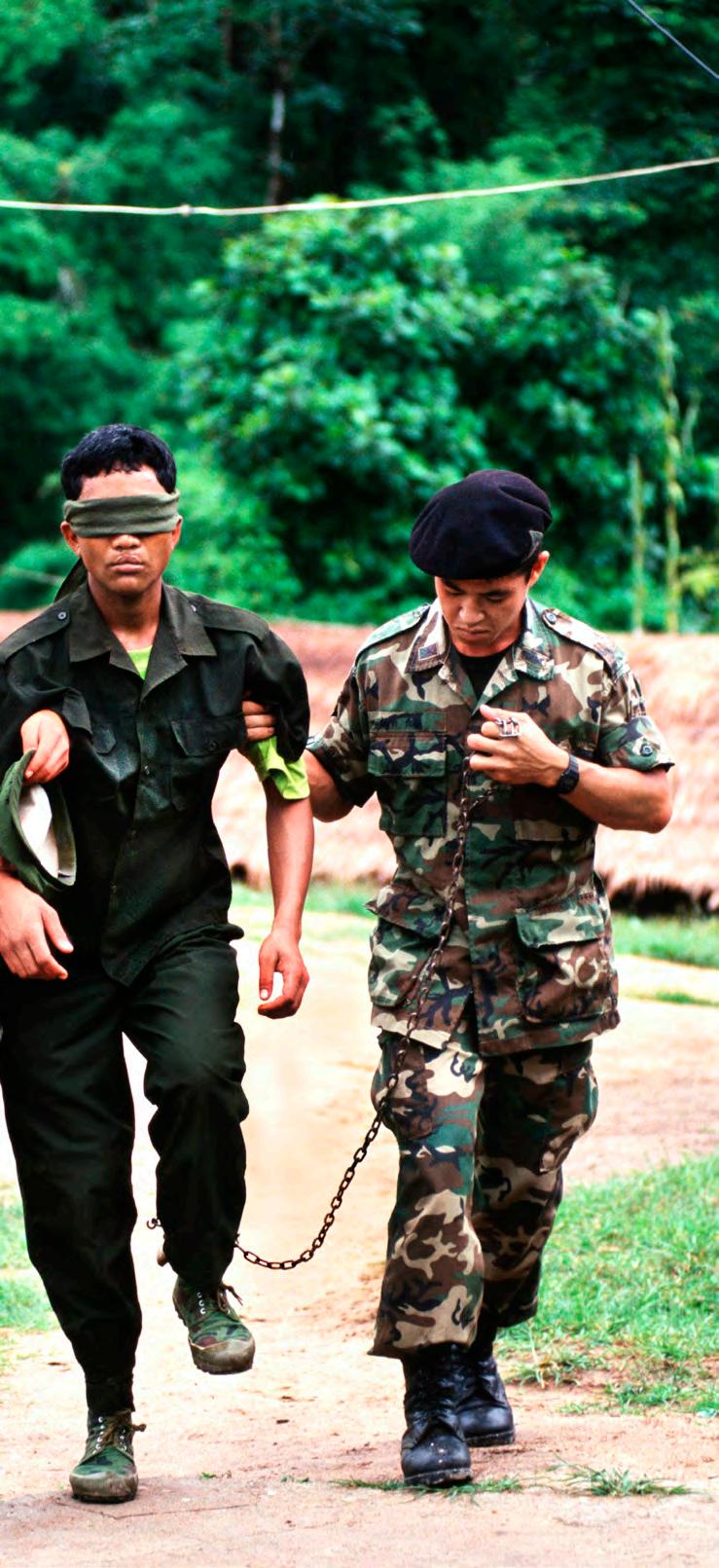

While some of the drugs are also trafficked into Malaysia from southern Thailand, most will stay in Thailand.
“Yaba [methamphetamine pills] mostly sell out in Thailand. But for ice [crystal methamphetamine] and heroin, sometimes they go down south, to Malaysia and other third countries,” Ms Siripong said.
In August 2011, Thailand’s Office of the Narcotics Control Board (ONCB) hosted a bilateral meeting on narcotics law enforcement cooperation, attended by both Thai and Myanmar delegations.
“We have very close cooperation [with Myanmar’s government],” Ms Siripong said. “And we share the information. We join hands to press them [drug traffickers]. We can’t say that we will succeed very soon. It may take time.”
She said Thailand is used as a transit country by drug traffickers from Myanmar, Laos, Malaysia and the Golden Crescent—Asia’s other major opium-producing region in the border territories of Afghanistan, Pakistan and Iran.
Thai soldiers arrest a UWSA courier on his way to collect money from amphetamine sales. (Photo taken in 1999.)Siripong said armed ethnic Wa and Kokang groups from Myanmar’s Shan State were the region’s main drug producers, operating heroin refineries and methamphetamine laboratories.
Veteran journalist Bertil Lintner, who wrote “Burma in revolt: Opium and Insurgency Since 1948,” said the reason for the illicit drug trade’s stubborn endurance was the prevalence of these yaba and heroin labs, run by operators who pay the United Wa State Army (UWSA) a protection fee to be allowed to set up labs inside the UWSA-
controlled territory.
With the cooperation of the Myanmar and Laotian governments, Bangkok put drug eradication on the national agenda. The government launched a war on drugs in 2003, killing about 3,000 people allegedly involved in the drug trade. But the campaign failed to fully eliminate the narcotics scourge.

As to the transnational nature of the effort, Mr Lintner has his doubts.
“I don’t think there’s much actual cooperation between those countries
[Myanmar, Thailand and Laos], just a lot of talk because they really don’t trust each other. They have meetings and seminars, but little or no cooperation on the ground.”
Most observers and analysts say it is impossible to completely eliminate drug trafficking, an ages-old trade.
A Thai drug dealer in the town of Chai Prakan, Fang District, described the nature of the drug trade as a slippery slope.
“If you get involved into [taking a] big step, you can’t stop it because the richer you get from the drugs, the bigger drug connections you get,” he said.
“And it is highly risky for you to stop the trade when big drug gangs know you. e ven if you want to stop, they won’t let you go because you know all their trade connections. They will hunt you until they kill you,” he added.
A former Shan rebel who was with Shan State Army-South (SSA-South), an ethnic Shan militia with strongholds along the Shan State-Thailand border,
said that when he patrolled in Shan State, his militia often clashed with armed drug trafficking gangs in the jungle transporting methamphetamine pills into Thailand.
he said armed drug gangs killed anyone they encountered on the trafficking route to eliminate the risk that the route and network might be compromised.
“No matter whether they are villagers, farmers, men, women or children—they kill all,” the former Shan rebel added.
Thierry Falise, a Bangkok-based photojournalist who has covered
Asia and the Pacific, said in the report, “These transnational criminal activities are a global concern now.”
Several huge drug seizures were reported in 2012 in Thailand. In january last year, Thai police seized 3.8 million methamphetamine tablets worth over 1 billion baht ($34 million) in Bangkok, the largest drug bust in years.
Khunsai jaiyen, the editor of the Thailand-based Shan herald Agency for News, linked the drug trade to political affairs in Myanmar.
Because of the Myanmar government’s failure to reach political settlements with armed ethnic groups,
Myanmar for more than 20 years and gained access to opium plantations in Wa territory, said the Wa have been producing opium for generations.

“A yaba factory is just a wooden or a bamboo hut, easy to conceal in the jungle. A heroin factory is built along a stream or a river but it’s also limited infrastructure, easy to hide,” Mr Falise said.
The UN Office on Drugs and Crime (UNODC) announced on April 16 that organized crime in the AsiaPacific region, which includes human trafficking, migrant smuggling, and the illicit drug and wildlife trades, is a US $90 billion-a-year business—twice the GDP of Myanmar.
The report said drug trafficking accounts for an estimated one-third of that. It found that an estimated 65 metric tons of heroin worth $16.3 billion flowed within the region in 2011, of which two-thirds was produced in Shan State.

An additional $15 billion worth of methamphetamine within the region was also manufactured in eastern and northeastern Myanmar.
j eremy Douglas, the UNODC regional representative for Southeast
the minority groups are forced to recruit militia members and fund their operations, he explained. The need for an army and arms leaves the ethnic groups few options but to get involved in border trading, including the illicit but profitable drug business.
“It is necessary to reach a political settlement,” said the veteran Shan journalist, who reports regularly on drugs in the region.
Mr Falise, the photojournalist, said the entirety of Thailand’s border with Myanmar has been used for decades by drug traffickers.
“There are thousands of trails, tracks and roads in the forest and hills marking the border. It’s impossible to control them all,” he said.
Mr Douglas of the UNODC spoke to the broader implications of the region’s drug trade, reaching far beyond addicts in Fang District.
“Illicit profits from crimes in East Asia and the Pacific can destabilize societies around the globe,” he said. “Dollars from illicit activities in east Asia can buy property and companies and corrupt anywhere.
“We need to talk about this, and organize a coordinated response now,” Mr Douglas added. “It takes a network to defeat a network.”
“No matter whether they are villagers, farmers, meN, womeN or childreN— they kill all.”
–A former Shan rebelMNDAA: Myanmar National Democratic Alliance Army
Bangkok is taking a new tack in its efforts to end a nearly decade-old insurgency in Thailand’s far south, but violence in the predominantly Muslim region rages on
 By MARWAAN MACAN-MARKAR
By MARWAAN MACAN-MARKAR
BANGKOK — On the day that the results of Malaysia’s general election were announced, confirming a narrow win for the incumbent, Prime Minister Najib r azak, there was an audible sigh of relief expressed in the Thai capital.
Such a response by Lt-Gen Paradorn Pattanatabut, head of the country’s powerful National Security Council (NSC), to the May 5 poll was understandable. It was a spark of good news in two weeks of dismal tidings linked to Mr Paradorn’s new challenge—charting a path to peace in the country’s three southern provinces, where a bloody insurgency has been raging.
In welcoming another term for Mr Najib, Mr Paradorn showed his appreciation for the role that the Malaysian government has played in facilitating two rounds of “peace dialogues” in Kula Lumpur. They have
enabled Mr Paradorn, who heads Bangkok’s negotiating team, to meet with Hassan Taib, chief liaison officer of the Barisan r evolusi Nasional–Coordinate (B r N-C). The latter is one of the most influential groups among an array of Malay-Muslim rebel organizations waging a militant campaign in the provinces of Pattani, Yala and Narathiwat, close to the Malaysian border.
In fact, the short, goatee-sporting hassan was among the sources of bad news for Mr Paradorn. On the eve of their second round of talks in the Malaysian capital, hassan delivered a verbal blast of demands using the video-sharing website YouTube, upsetting Thai conservatives and giving ammunition for doubters of the peace process in the local media.
This online message by Mr hassan and another BrN-C hardliner called for Malaysia’s role at the dialogues to be upgraded to a mediator and wanted
the discussions to have international observers, ranging from the Association of Southeast Asian Nations (Asean) to the Organization of Islamic Cooperation (OIC), the global network of over 50 Muslim countries.
The five-point demands on April 28 also turned up the heat on Mr Paradorn’s team by referring to the talks as a dialogue between “between Patani people and colonialist Siam” and insisting that Bangkok should consider the B r N-C as a “Patani people’s liberation movement, not
separatist.” Such an attempt to raise the political significance of the BRN was being made, according to hassan, to meet the demands of the MalayMuslims, who are the predominant ethnic community in an otherwise Buddhist-dominant Thailand.
A similar justification was behind the B r N-C’s fifth demand: for the Thai authorities to unconditionally release all Malay-Muslims in custody for alleged links to the insurgency and “remove all warrants.”
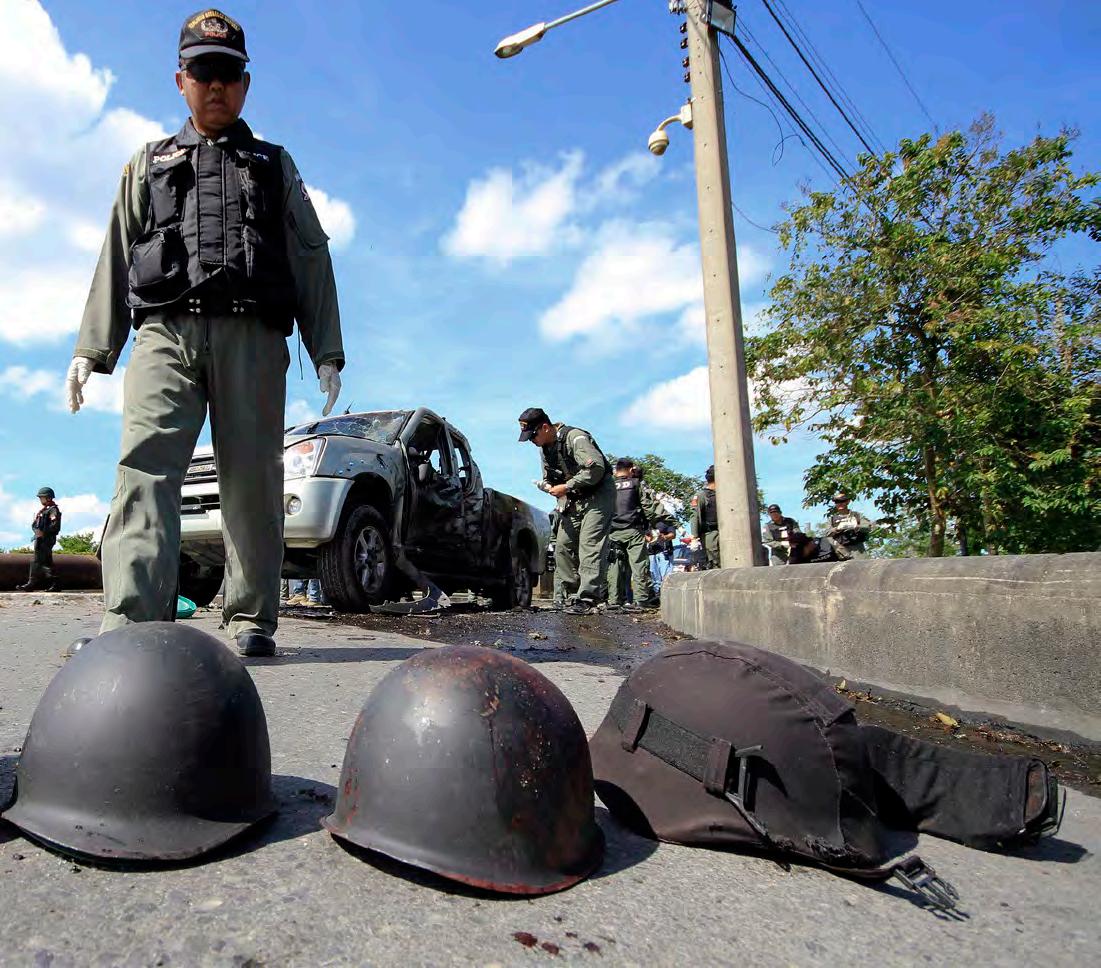

Such openly publicized demands
by the BrN-C caught Mr Paradorn off guard, forcing him into damage-control mode before he met Mr hassan in Kuala Lumpur on April 29. Malaysia’s role as a facilitator will remain unchanged and there is no need for other international observers, Mr Paradorn remarked, striking a dismissive tone. Yet to the other demands, he appeared conciliatory. It aimed to calm the worries of Thai nationalists, while at the same time convey to the BrN-C that he was prepared to listen to keep the peace talks on track.
he expressed a similar sentiment after he returned to Bangkok following eight hours of talks with the BrN-C. “There is something positive in the message they made on YouTube. It means they trust us to share their views,” the tall and calm-looking Mr Paradorn revealed to a small group of foreign journalists at his office. “That is important because at this stage we need to create mutual trust and understanding.”
And given the nature of the discussions so far, Mr Paradorn viewed
the B r N-C’s five-point demands as hardly a source of alarm—at least for now. “At this stage, there haven’t been any negotiations, only a dialogue,” he noted. “We are listening to each other.”
Yet he has not stopped there. “We have asked Thai officials to listen to the conditions made by the B rN,” he explained, revealing the extent to which Bangkok is prepared to go to keep the B r N-C and other MalayMuslim negotiators at the peace table. “It is important to listen to the different views of local people.”
If bending over backwards to keep the BrN-C negotiators on board is Mr Paradorn’s strategy, so far it has had little success in winning over the MalayMuslim militants on the ground. The violence has continued with regular ferocity before and since the April 29 talks. One particularly gruesome attack happened in Pattani two days after
quest for peace is winning praise from a few conflict resolution experts based in the south. “The government is approaching the peace talks as a longer process, which is an important message to get out to those involved in the violence,” noted one expert, speaking on the condition of anonymity. “The idea of sitting around the table is a significant step to stop the violence.”
Such an attitude is a shift from the attempts by past Bangkok administrations. “The previous efforts were not process driven. It came across as an exercise in firefighting,” the expert added. “And those efforts offered nothing to convince the Malay-Muslim militant groups that the Bangkok government was serious about resolving the conflict.”
Already, the Yingluck administration has achieved a few milestones to its name since Feb. 28, when, during an
exile to avoid a two-year jail term in Thailand for corruption. h e turned to Malaysian premier Najib and the country’s powerful Special Branch to rope in leaders of the B r N-C for a peace pact, says a source well connected to the Malay-Muslim insurgents. “Thaksin tried it last year, in March, when he met some of the Malay-Muslim leaders in Kuala Lumpur,” the source revealed. “But it did not go anywhere, since Thaksin was in a big hurry, and there were no serious offers made.”
Yet Mr Thaksin persisted, a fact that he even acknowledged in an interview with Thai rath, Thailand’s largest daily newspaper. The deal had been shaped over a year of discussions, he told the Thai-language newspaper shortly after the late February peace pact was inked.
For an insider of the governing Pheu Thai party, where Mr Thaksin is the de facto leader, the latter’s role in the quest for peace is hardly surprising. After all, he admitted, the current cycle of violence was triggered during Mr Thaksin’s first term as premier and escalated until he was ousted by the military in a September 2006 coup. “he has already made a public apology for his harsh policies in the Deep South,” says the Pheu Thai insider. “The current peace process is one way of making amends.”
the second peace dialogue, when four armed men dressed in black drove to a grocery store and killed six Buddhist civilians. The victims included a threeyear-old boy.
And roadside bombs continue to be used by the insurgents targeting the military, police and government officials. The violence between Feb. 28, when Thai Prime Minister Yingluck Shinawatra first acknowledged that her government had endorsed a peace pact with the BrN-C, and the second peace dialogue, at the end of April, has seen 23 people killed and 117 injured. They have contributed to a grim picture in the troubled south, where more than 5,300 people have been killed and over 9,000 injured since this latest cycle of the ethnic conflict erupted in january 2004. A majority of the dead are Malay-Muslims, with various arms of the security forces being fingered for the body count, as well as the runda Kumpula Kecil ( r KK), the armed fighters of the BRN-C.
That these setbacks have not dimmed the Yingluck administration’s
official visit to meet her Malaysian counterpart, Mr Najib, a peace pact was signed between Mr Paradorn and Mr hassan. The current government is the first to openly acknowledge that the conflict in the south is a separatist insurgency. It contrasts with the way the militants were described by previous governments (including one that was headed by a former army chief) as being members of drug networks, bandits, misguided Muslims or even mysterious “armed ninjas.”
The BrN-C’s YouTube statement to shape the peace dialogue also broke new ground. It is the first time that an organization involved in the MalayMuslim insurgency has revealed a face in public offering a political manifesto, of sorts. h itherto, the rebel groups preferred to spread their messages and demands through flyers, banners and posters that bore no hint of their authors’ names.
The ground for these shifts was prepared by Ms Yingluck’s elder brother, Thaksin Shinawatra, the former prime minister now living in
But for the Yingluck government, challenges lie ahead once the current listening phase shifts gear to the tougher negotiating phase. After all, the current ethnic conflict is rooted in a troubled history going back to 1902, when the three southern provinces were annexed by Siam, as Thailand was called. Until then, these provinces were part of the Malay-Muslim kingdom of Pattani, which also stretched into northern Malaysia.
Bangkok-centric policies, coupled with economic, cultural and linguistic marginalization, fed resentment among the locals in Narathiwat, Yala and Pattani. The cry for separation and the rise of a Malay-Muslim militancy emerged in the last century.
“The Thai state sees itself as superior and the Muslims [as being] at the receiving end of the state,” says Sunai Phasuk, Thailand researcher for h uman r ights Watch, the global rights campaign organization. “The peace process will have to eventually address issues like discrimination and the lack of justice.”
“the idea of sittiNg arouNd the table is a sigNificaNt step to stop the violeNce.”

anyone who is interested in myanmar reads The Irrawaddy. among our readership we count policy-makers and government officials throughout the world. diplomats, un officials, ngo workers, journalists, students and activists both abroad and inside myanmar regularly read our magaine and website.


access our website at www.irrawaddy.org or subscribe to our free daily email update service.



Though the ruling coalition managed to retain its hold on power, its leader faces tough questions about the direction of the country
By STUART GRUDGINGSMalaysia’s racially divisive election result has sparked a battle within the country’s ruling party that is likely to slow Prime Minister Najib razak’s drive to reform the economy and roll back policies favoring majority ethnic Malays.
Najib’s Barisan Nasional (BN) coalition retained power in the May 5 election in the multi-ethnic Southeast Asian nation. But the coalition lost the popular vote and turned in its worstever electoral performance as it was heavily abandoned by the minority Chinese and rejected by many voters of all races in urban areas.
Najib was quick to blame the outcome on the swing by Chinese voters to the opposition alliance, putting a racial interpretation on the result that has struck a chord with traditionalists in his United Malays National Organization (UMNO).
UMNO, which dominates Barisan, now faces a leadership election in October or November that is likely to be fought between traditional and reformist wings.
“The ideological lines have been drawn within UMNO,” said Khairy j amaluddin, a reformist who heads the party’s youth wing, in a posting on Twitter. “Game on.”
Any major reforms are likely to
be postponed until the leadership is decided, although Najib has said he will push for national “reconciliation” and press ahead with a US $444 billion economic master plan aimed at attracting investment and doubling incomes by 2020.
Conservatives have blamed ethnic polarization and Chinese “disloyalty” while reformists have urged Najib to expand steps to make UMNO more inclusive beyond its base of poor, rural Malays.
Utusan Malaysia, a newspaper controlled by UMNO, sought to portray the election results in racial terms, with one headline saying: “What more do the Chinese want?”
Malaysia’s former and longestserving prime minister, Mahathir Mohamad, a powerful figure in UMNO, was quoted by local media as saying “ungrateful Chinese” and “greedy Malays” were to blame for the result.
“It may be the starting shot of what’s to come for Najib,” Oi Kee Beng, deputy director of Singapore’s Institute of Southeast Asian Studies, said of conservative reactions to the result. “At the same time, I think he is their [UMNO’s] best asset despite everything.”
Najib also has to deal with a strong opposition that is claiming that Barisan won the election through fraud. Three
days after the polls, tens of thousands of opposition activists thronged a stadium on the outskirts of the capital Kuala Lumpur in response to a call from opposition leader Anwar Ibrahim.

“This is merely the beginning of the battle between the people and an illegitimate, corrupt and arrogant government,” Anwar, a former deputy prime minister, told the crowd, many of whom wore black to symbolize mourning.
Najib, the 59-year-old son of a former prime minister, had far higher approval ratings than his party in the run-up to the election and has few obviously strong rivals to replace him.
Taking power in 2009, he staked his fortunes on reforms aimed at spurring growth, increasing transparency and dismantling affirmative action policies.
But Najib’s ambitions have been curbed by conservative interests within
UMNO. he has failed to come up with major steps to roll back the ethnic privileges that are seen as having benefited an elite of well-connected Malays more than the poor majority.
The government does not provide an ethnic breakdown of the population, but Malays make up about 60 percent of the 28 million people, while Chinese comprise more than 25 percent. The country also has a significant minority of ethnic Indians.
Barisan won 133 seats in the 222-member parliament, but only 47 percent of the popular vote, compared to the opposition’s 50 percent.
“The polarization in this voting trend worries the government,” Najib said. “We are afraid that if this is allowed to continue, it will create tensions.”
But Barisan has also come in for criticism from younger voters for
Malaysia’s opposition leader Anwar ibrahim delivers a speech during a rally on May 8 protesting the results of an election held three days earlier that returned the ruling party to power.


corruption and patronage politics that critics say have been the hallmark of its 56 years in power.
Liew Chin Tong, an opposition member of parliament from the southern state of j ohor, said Najib appeared to be taking the wrong message from the election result.
“It was not just the Chinese who swung against Barisan Nasional. There were many young first-time and second-time voters who voted against the BN,” he told reuters.
Najib now looks more vulnerable to traditionalists in his party who are opposed to his tentative steps to phase out the policies that favor ethnic Malays, introduced two years after traumatic race riots in 1969.
Those policies have been a pillar of UMNO’s support but have been a prime cause of ethnic Chinese and Indian alienation and investors say they stunt growth and investment in Southeast Asia’s third-largest economy.
Najib’s efforts to roll back these policies and other politically sensitive reforms—such as the introduction of a consumption tax to reduce Malaysia’s dependence on oil revenues and lowering fuel and food subsidies to tackle a chronic budget deficit—could be put on the backburner for now.
“The outlook for direct investment will remain uncertain until it becomes clearer whether or not Najib’s reformminded policies will continue,” hSBC economists said in a note after the result.
The opposition’s Liew said Najib’s choices of cabinet members would be a crucial indication of whether his new government would try to appeal across ethnic groups or only to its Malay base.
“his comments on the Chinese is rhetoric,” Liew said. “What we need to see is who he will include in his cabinet. Will it be made up of UMNO extremists or younger members from the middle ground? We also have to see if he will include the Chinese.”
“we are afraid that if this is allowed to coNtiNue, it will create teNsioNs.”
–Malaysian Prime Minister Najib Razak
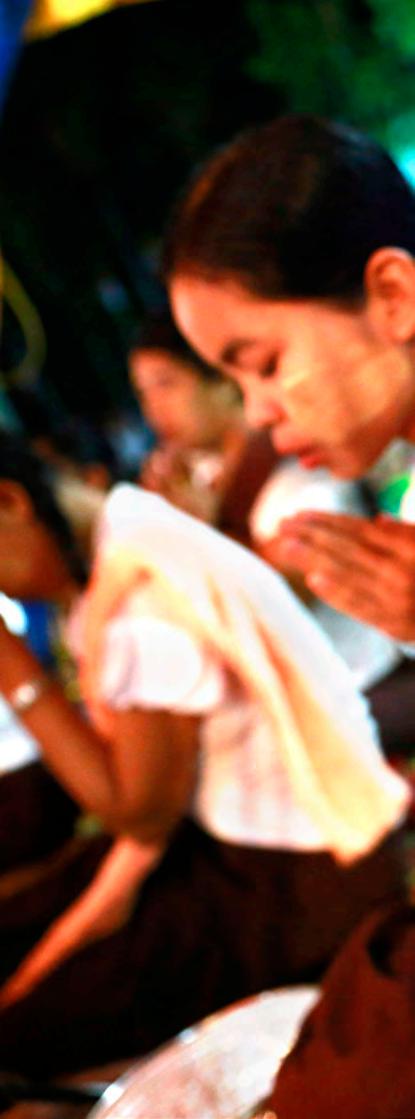

While
By KYAW ZWA MOEMAWLAMYIN e , Mon State — It’s around 8 pm on a recent evening in Mawlamyine, the capital of Mon State, and U Wimala, a Buddhist monk, is about to arrive to deliver a sermon at a temple in the city’s Aut Kyin quarter. Despite his reputation as a charismatic speaker, however, there are barely a hundred people inside the main religious hall, and perhaps another hundred—mostly children—outside.
Above: U Wimala delivers a sermon to Buddhist followers. Right: Young women at prayer; one wears a t-shirt with the 969 sign.traditional Buddhism urges its followers to seek peace of mind, a new brand of Buddhist nationalism strives to stir up anti-Muslim passions
“Please go in,” some women tell me and a few others who are standing outside. “There are not so many people here tonight, so the Sayadaw might be upset.” Meanwhile, loudspeakers blare out a song that sets the tone for the talk that is about to be given: “We Buddhists shouldn’t stay calm. If we are calm, our race and religion will vanish.”
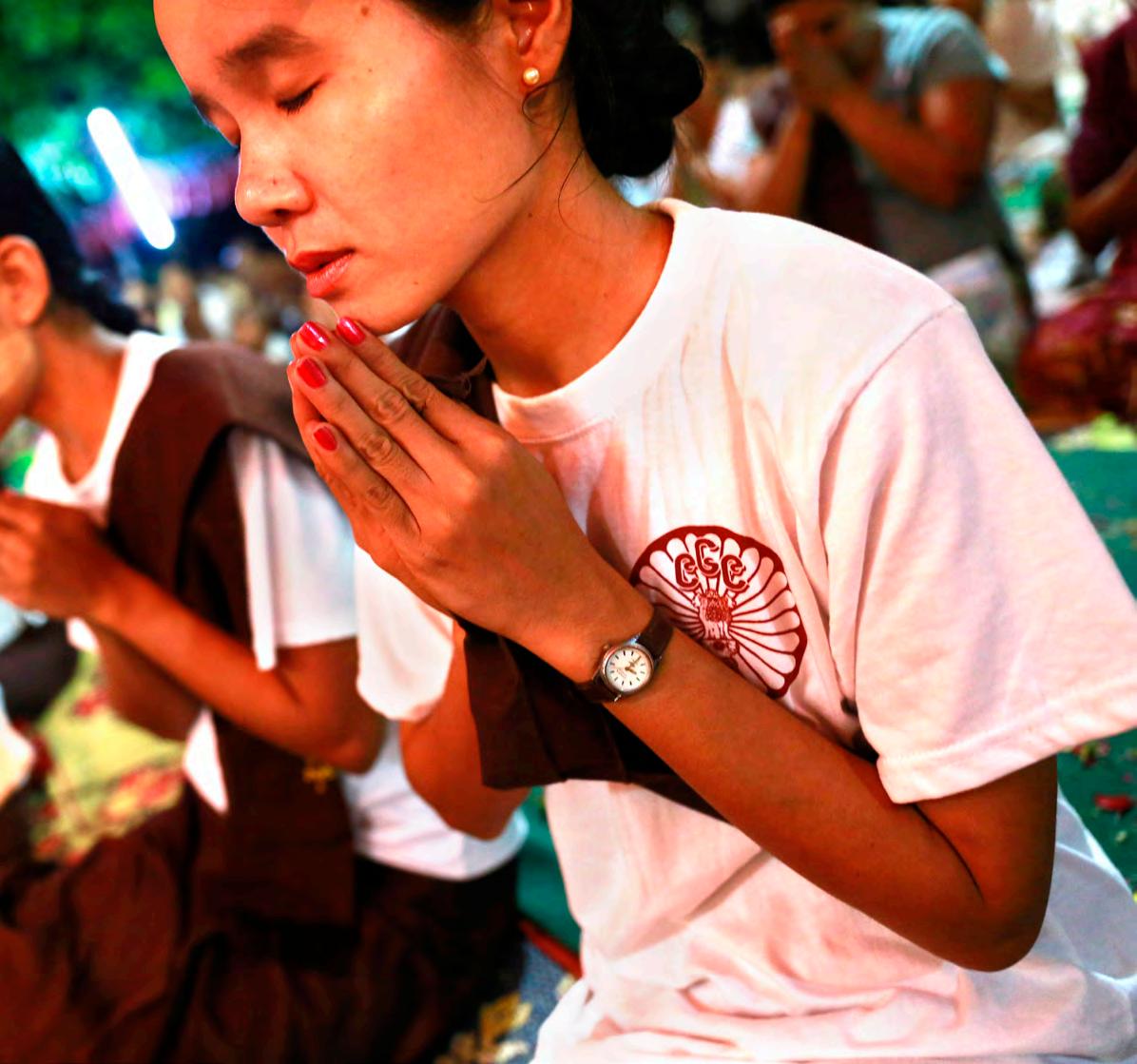
A few minutes later, U Wimala, who looks much younger than his 40 years, makes his appearance. After chanting a short Buddhist prayer, he begins his
sermon with an ominous warning: “We Buddhists are like people in a boat that is sinking. If this does not change, our race and religion will soon vanish.”

“And so,” he adds, “tonight’s sermon will be about 969.”
He pauses briefly, then asks, “What is tonight’s sermon about?”
“969,” his audience replies.
“What is it about?” he repeats through his microphone, raising his voice.
“969!”
“Louder! You have to shout it louder. even if your voice makes this Dhamma Yone [religious assembly hall] collapse, we can rebuild it.”
It was a strange scene, more reminiscent of a political rally than a Buddhist sermon. But it didn’t come as a surprise: U Wimala was well known as a firebrand monk and a leading exponent of the 969 movement that has in recent months attracted a great deal of attention in the country and, indeed, around the world. regarded as a brand
of extreme Buddhist nationalism, it has been linked to recent outbreaks of antiMuslim violence in central Myanmar that many worry could turn into a nationwide conflagration.
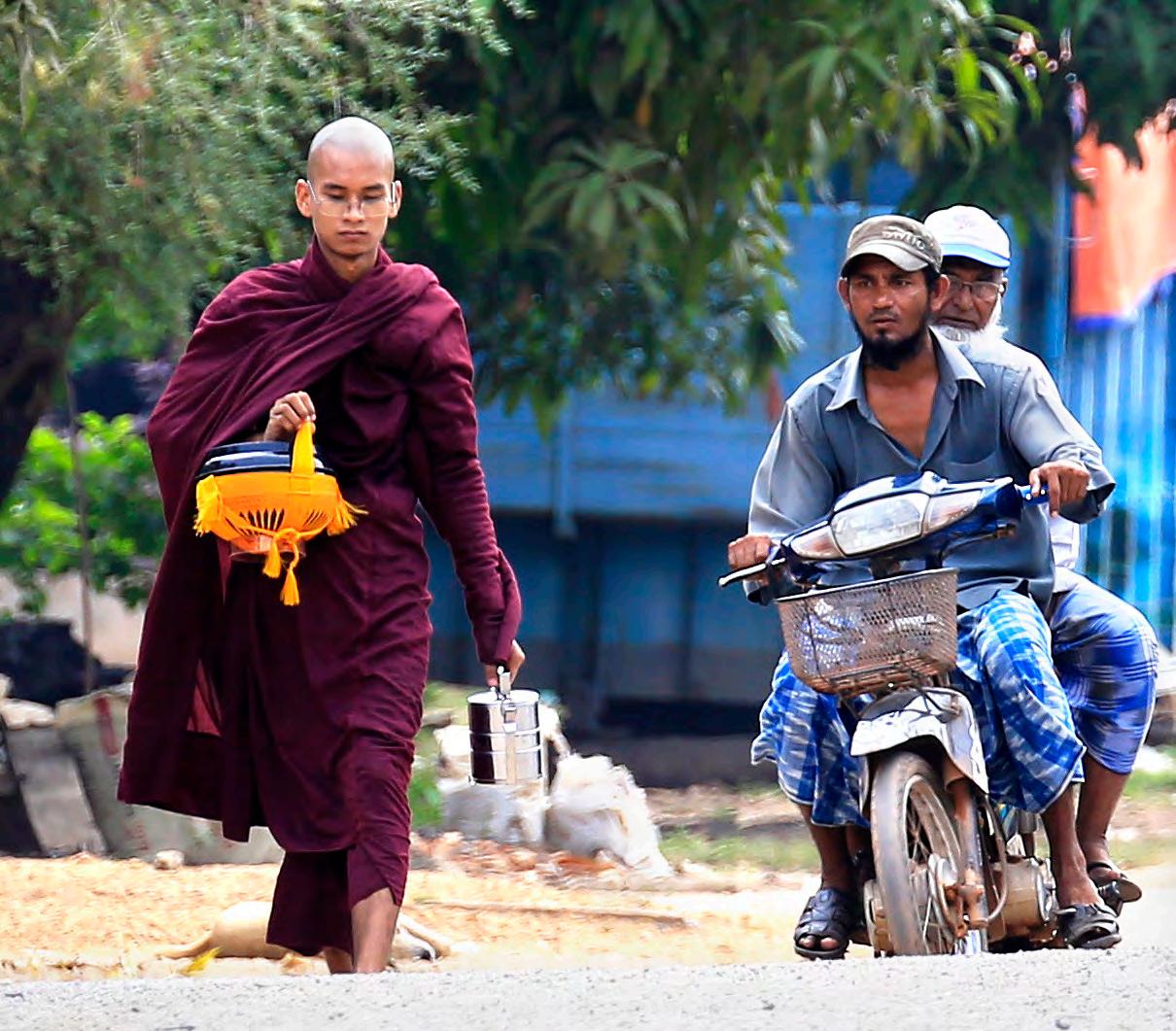
The women who had guided us into the building also handed us pamphlets spelling out what 969 stands for. “We Buddhists must protect our race and religion by worshiping and applying 969,” the tracts say.
U Wimala explains in his sermon that the numbers in 969 refer to the nine
special attributes of the Buddha, the six special attributes of his Dhamma, or teachings, and the nine special attributes of the Sangha, or community of monks. While most regard 969 as a relatively new movement, for U Wimala it is as old as Buddhism itself.
“You must remember,” he says in a booming voice, “that 969 has existed for 2,600 years. Christianity emerged 620 years after 969, and Islam more than a thousand years after 969.”
At the same time, however,
he acknowledges the movement’s newfound notoriety.
“Some people ask, ‘Is it legal?’ I don’t even know how to answer that question. Isn’t the Buddha legal? We monks are legal, aren’t we?”
he also insists that the movement is non-violent. But to achieve its goals, the 969 movement has been campaigning to boycott Muslim-owned businesses bearing the number 786, which is used by Muslims in Myanmar to mark halal restaurants and shops.
A monk collecting alms and two Muslim men on a motorbike share a road in Mawlamyine.“We have never spoken of beating or killing people of different religions,” he insists. “Our Buddha taught us never to kill any creature, let alone people or members of different religions.”
But if these words were intended to reassure Muslims, who make up roughly half the population of Mawlamyine’s Aut Kyin Quarter, they failed.
“It’s scary, the way he speaks,” U Tin Aung, a 68-year-old Muslim man, told me outside the temple after the

sermon. It wasn’t so much the words, he said, but the intensity with which they were delivered.
Muslims are not alone in feeling that there’s something distinctly unnerving about the way the 969 movement seeks to instill fear in the hearts of Buddhists about a supposed Muslim conspiracy to drive their faith out of Myanmar, where it has taken firm root over the past two millennia.

“This is the first and last time,” said one of the organizers of the evening’s sermon. “We intended this for young people and kids. We didn’t know he would talk about all this 969 stuff.”
Others I spoke to were also less than impressed by U Wimala’s fiery rhetoric.
“h e sounds like h itler,” U h tun Than, a 57-year-old Buddhist and former political candidate in Myanmar’s 1990 elections, told me bluntly after we sat through the sermon. “It will be a big problem if his group becomes stronger.”
U Kyaw Kyaw, another local politician from the opposition National League for Democracy (NLD), agreed. “You heard the song: ‘We shouldn’t stay calm. If we stay calm, our race and religion will vanish.’ What is that supposed to mean? They are just agitating people. It has to stop.”
had a well-earned reputation for being staunchly Buddhist, even as British rule brought with it an influx of mostly Muslim migrants from India, whose descendants now make up roughly a fifth of the city’s population.
The 969 movement itself goes back to 1997, when a 40-page booklet titled “969” first appeared in Mawlamyine. Published by hna Phet hla (literally, “the beauty of both sides”) and penned under the name U Kyaw Lwin, this short manifesto urged Buddhists to openly display the numbers 969 on their homes, businesses and vehicles. It didn’t, however, single out any other religion for criticism. Instead, it merely called on Buddhists to be good people and support each other.
A few years later, however, another booklet started circulating that carried an overtly anti-Islamic message. Called “Worrying about the Vanishing of the r ace,” it also emphasized the need to behave properly, but among its 17 prescriptions for protecting the Buddhist religion were some that encouraged active discrimination against Muslims.

The book, which first appeared around 2000 and was never legally published (meaning that anyone found in possession of it faced a seven-year jail sentence under Section 5 (j) of the 1950 e mergency Act), said that
During our conversation, U Kyaw Kyaw reminds me that the 969 movement has its roots in Mawlamyine, a city long known as a bastion of the Buddhist faith.
It was here, nearly two centuries ago, that local protests forced the closure of a missionary school after a Buddhist student converted to Christianity. Since that incident, which occurred just 12 years after the British assumed control of the southern part of Myanmar in 1824, Mawlamyine has
Buddhists should employ a “three cuts” strategy against Muslims. This entailed cutting off all business ties; not allowing Buddhists to marry Muslims; and severing all social relations with Muslims, including even casual conversation. It stopped short, however, of advocating violence.
e ven now, the 969 movement disavows violence, even as it is increasingly seen as playing a key role in stirring up anti-Muslim sentiment. Ostensibly, at least, its activities are
“they are just agitatiNg people. it has to stop.”
–U Kyaw Kyaw, of the NLD’s Mawlamyine branch
peaceful. U Wimala, for instance, has instituted Sunday schools to teach Buddhist children the basics of the Buddha’s teachings and social ethics. Some parents have been wary of sending their children to these schools, however, fearing they will be exposed to hate speech. But some of these schools attract as many as a hundred students, attesting to their popularity in some communities.
Proponents of the 969 movement insist that their goal is merely to protect their own religion, not attack the beliefs of others. But when asked why they urge Buddhists to boycott Muslim businesses, U Yaywata, the vice abbot of Mya Sadi Nan Oo Monastery in Mottama, on the opposite side of Mawlamyine, tells me that it is no more than a reaction to a Muslims’ discrimination against Buddhists.
“I want to ask, who started this practice? For years, Muslims have refused to buy anything from Buddhist shops, even from betel nut sellers. They use 786 to support each other, so we have to do the same thing.”
Sitting next to a bag full of 969 stickers—the most visible symbol of the movement, and an increasingly common sight in many parts of Myanmar—the 38-year-old monk continues: “Why doesn’t Islam allow Buddhists to keep their religion if they marry Muslims? Their kids also have to become Muslims. Their religion doesn’t allow freedom of belief and worship. They are violating basic human rights.”
By adopting methods that they accuse Muslims of using against Buddhists, the followers of 969 are indeed having an impact. U Tin Aung, the Muslim man who spoke to me after U Wimala’s sermon, said that his son’s motorcycle spare parts shop has lost almost half its business in recent months. however, because his son’s shop has a reputation for offering fair prices and good service, many customers are returning, he added.
Meanwhile, some Buddhists who pasted 969 stickers on their vehicles and houses have started taking them off. A motorcycle taxi driver said that after he put a 969 sticker on his bike, he started losing Muslim customers. So he removed it—not just because it was costing him money, he said, but also because he realized that the 969 movement was fundamentally racist.
U Tin Aung said he believed the worst of the 969 movement’s misguided campaign to vilify Muslims had passed. “You know, people are interested in new things. It’s just human nature, but it doesn’t last,” he said.
“The essence of any religion is peace, sympathy and beauty,” he added.
The 969 movement may be a relatively recent phenomenon in Myanmar, but intolerance is, unfortunately, nothing new to the country. While religion is occasionally seen as contributing to this problem, many observers would point a finger elsewhere, at state policies that have long exploited religious and ethnic differences to cement the military’s hold on power.
“Ne Win is the real culprit, not 969,” said U htun Than, the politician who ran for election in 1990. recalling that Muslims enjoyed equal status in

“we buddhists are like people iN a boat that is siNkiNg. if this does Not chaNge, our race aNd religioN will sooN vaNish.”
–U Wimala
Myanmar until Gen Ne Win seized power in a coup in 1962, paving the way for half a century of military rule, U htun Than blamed the policies of the former ruling Burma Socialist Programme Party for deepening mistrust among Myanmar’s different religious groups.
“The BSPP made religious discrimination official policy, forcing Muslims to increasingly rely on each other for support,” he said. This, he added, resulted in growing resentment among Buddhists, who came to see Muslims as a people apart.
Despite decades of being treated with disdain, however, Muslims say they don’t mind social attitudes toward them so much as the failure of the country’s leaders to treat them as full Myanmar citizens.

“We don’t care about being called dogs or kalar [a derogatory term for people of South Asian descent], we just want our basic human rights,” said U Myint Lwin, a teacher at the Moree
Mosque in Mawlamyine’s Swan Gyi Quarter.
Although Myanmar has recently undertaken reforms and President U Thein Sein has promised to protect the rights of Muslims in the wake of the latest outbreak of anti-Muslim violence that began in Meikhtila in late March, U Myint Lwin said that it is still far from clear where the government stands on this issue.
“Look at how quick the authorities were to crack down on protests against the Letpadaung copper mine,” he said, referring to a controversial Chinesebacked project in Sagaing r egion. “Why were they so slow to take action in Meikhtila and other cities? If they had done their job there, the casualties and the loss of property would not have been so bad.”

Asked if he felt disappointed that NLD leader and Nobel Peace Prize laureate Daw Aung San Suu Kyi has not been more vocal about attacks on Muslims, he said it was probably for the best that she hasn’t spoken out on their behalf.
“We want her to be quiet on this issue. But we know that she feels sad for us,” he said, adding that he believed the situation would improve if Daw Aung San Suu Kyi became president.
In the meantime, Myanmar’s
Muslims are bracing for more attacks. Since the anti-Muslim riots in Meikhtila claimed 43 lives, there have been other attacks elsewhere in the country, most recently in Okkan Township, Bago region, in early May.
“Since the Meikhtila riots, we haven’t been able to sleep well,” said U Zaw Naing, another Muslim man at the Moree Mosque.

In Swan Gyi Quarter, where the mosque is located, roughly 80 percent of the 1,400 or so households are Muslim, making it a likely target if the recent wave of violence spreads to the birthplace of the 969 movement.
There have been few incidents so far, but tensions are rising. A number of mosques, including Mawlamyine’s largest, have had stones thrown at them, and when strangers show up in Swan Gyi, local residents become nervous.
“I don’t want to blame anybody, because we don’t know who threw the stones, but these things only started after the 969 DVDs started circulating,” said U Myint Lwin.
“Actually, it doesn’t matter who threw the stones. What we care about is the instigators, the ones spreading hate speech,” he said. “And we know who they are: the 969 group.”
In the end, he added, if this conflict gets out of hand, it will hurt everybody. “Both the winners and the losers will suffer great losses,” he said.
the now ubiquitous emblems of the radical anti-Muslim 969 campaign glare at you from Myanmar’s shop fronts and taxi windscreens. Bootleg DVD sellers hawk discs featuring the sermons of prominent 969 monks alongside the bestselling Korean soap operas. But despite the obvious prominence of the campaign, its radical teachings promoting segregation of Buddhists and Muslims are far from being embraced by everyone. Irrawaddy reporter Kyaw Phyo Tha spoke to a 969 leader, Myanan Sayadaw U Thaddhamma, and an anti969 monk, U Pantavunsa, to learn more about this controversial movement.
What is the 969 movement?
The central tenet of Buddhism is the Three Gems—Buddha, Dhamma and Sangha. If they are not in the hearts of Buddhists, the faith will be gone. 969 represents all three. We’ve invented the numerical logo as an emblem of Buddhism, just as a reminder to all Buddhists to contemplate the attributes of the Three Gems, and to promote the religion among those who are not very interested in it.
How long have you been promoting the 989 movement?
I’ve been working on propagating Buddhism for a long time, but just six months on 969. It’s the brainchild of Buddhist scholars who have been studying and teaching the Buddha’s doctrine to hundreds of monks in Mawlamyine. After several meetings and thorough discussions, we launched our mission.

Your ‘mission’ is widely regarded as anti-Muslim. Do you have any comment to make about this?
It’s just speculation. We have nothing to do with saying “no” to other religions. We are just working for Buddhism. People may have different views on what we are doing. We are not trying to defeat other faiths, just strengthen our own.
Myanan sayadaw U thaddhammaDuring recent anti-Muslim riots, 969 logos were sprayed on the walls of destroyed buildings. Was 969 behind this?
You should keep in mind that it depends on how people use our emblem. There might be some people who use it as a pretext to promote their cause. But our goal is not like that. Let me remind you that 969 originated in Mawlamyine. If we masterminded all those conflicts, Mawlamyine would have been the flashpoint. No religious conflicts have been reported so far in southern Myanmar and the Ayeyarwady delta, where we gave our talks about 969. Given all these facts, we are guessing that some people misused our logo.
If people are misusing your logo, do you have a message for them?
Three Gems is like water that can bring peace of mind to people. We are like someone delivering that water. But if some people mix it with poison, it has nothing to do with us. I have to say they’ve misused it. We have to blame their stupidity. It’s religiously inaccurate to use our emblem improperly. It’s also naïve to say that 969 is behind the unrest. I want to warn them not to use religion as a pretext for their interests. They will only end up with bad results.
Have you ever thought that your campaign may spark religious conflicts?
honestly, no. It has never come across our minds. As I’ve mentioned before, we are like water deliverers. If you impose a ban on the delivery due to its negative consequences, it shows how unwise you are. What happened during the unrest was something that shouldn’t have happened.
During your 969 sermons, you urge Buddhists to shop only at Buddhistowned businesses. Don’t you think that is an act of discrimination?
I’ve never urged my followers not to trade with people of different religions. I only encourage Buddhists to help and take care of each other. Since members of other religions often only patronize their own businesses, why shouldn’t we support our Buddhistowned businesses? If they [Muslims] have that kind of discipline, we should have our own discipline for ever-lasting Buddhism.

Myanmar is the only country in the world where Theravada Buddhism flourishes very well. When our Buddhists are less interested in the faith, our religion will be under threat. Apart from Buddhists, who else will take care of Buddhism? That’s why we are working hard to make people more interested in the religion.

Do you have any response for those who say 969 is religiously narrowminded?
They are just saying that without studying our mission closely. Since the campaign is led by scholarly monks, you can take for granted that our vision isn’t religiously narrow-minded. It’s not masterminded singlehandedly. What I want to tell the world is that, like the example I gave, we are just delivering water, the water of the Three Gems.
we have NothiNg to do with sayiNg ‘No’ to other religioNs. we are for buddhism.
Do you believe in the 969 campaign?
I no longer believe in it. If the campaign is just for meditation or to propagate Buddhism, it’s OK. But what is happening now is some people staged religious attacks using 969 as a pretext, and sparked racial and religious conflicts. This totally deviates from its mission. We still have four major religions all over the world. It’s nonsense in this globalized world to encourage people to discriminate against one religion in favor of another. That idea also diverts from our democratization process. It will prevent us catching up with the rest of the world from a human rights point of view. According to Theravada principles, we just have to follow what the Buddha taught. he never taught anything like what the 969 campaigners are saying now.
Did the Buddha instruct his followers to support Buddhism?
Never. h e had some rivals with very different convictions, but he never spoke against them. There is a well-known story of a rich man who previously supported one of the Buddha’s rivals, but who later became a lifelong disciple of the exalted One after hearing his teachings. But even then, the Buddha told his new follower to continue supporting his old mentors. It shows that he never lectured his disciples to be against others who have different beliefs.
Although the 969 campaign is spearheaded by monks, I’m sure they have no intention to see destructive consequences sparked by their sermons. They are just scapegoats used by some people who want to destabilize the country.

If they are being used, who is using them?
It’s beyond my knowledge, but if you study the patterns of recent riots, you can’t deny
the fact that they were well organized and there must have been someone behind them. Thirty-thousand copies of a DVD with 969 talks in Mon State have been distributed in Yangon. So, it’s very evident that they have a sponsor to distribute them on a large scale. There are several possibilities: cronies who would be comfortable doing business with the former military regime or some hardliners reluctant to undergo reform who might secretly finance them. Who knows?
iN the past, they baNNed some moNks who spoke out about democracy aNd daw auNg saN suu kyi from speakiNg iN public. why doN’t they take actioN this time, too?


But don’t you think that what the monks are preaching is fueling antiMuslim sentiment?
Of course, I do. Their actions are against the instructions issued by the Sangha Maha Nayaka, the state-controlled monastic council. What we are not pleased with is that the government used excessive force to crack down on protesters, including monks, of the Chinese-backed Letpadaung copper mine, while they are not bothering to open fire on rioters who were looting, torching and beating Muslims right before their eyes. That makes me feel very uneasy. On the other hand, what those 969 monks preach makes it more difficult for peaceful co-existence between the two communities. In the past, they banned some monks who spoke out about democracy and Daw Aung San Suu Kyi from speaking in public. Why don’t they take action this time, too?
Why has the 969 campaign become so popular?
Because the authorities concerned haven’t taken the necessary action. Plus, even though most of Myanmars are tolerant, there is underlying anti-Muslim sentiment. It’s quite similar to what happened in the past when we heartily supported anyone who said anything bad about the military.
Why has the government failed to stop the spread of the violence?
They might have thought the violence would not have spread that much. Maybe they didn’t take 969 seriously. In spite of the president’s request for all-inclusive approaches to prevent unrest, we have found that, to our dismay, some officials working on the ground are still reluctant to implement them. They keep complaining that they are just waiting for orders. In short, I blame the mismanagement of the government.
At a press conference on March 29, U Min Ko Naing of the 88 Generation Students group said the evidence was “very clear” that the riots that broke out in Meikhtila in late March and quickly spread to other areas of Myanmar were instigated by “welltrained terrorists.” The painful events that occurred in my home country of Bosnia in the 1990s are not altogether unlike those of Myanmar today. e thnic cleansing is never spontaneous, or a result of “ancient
hatreds,” which was the phrase used to describe the former Yugoslavia’s descent into conflict. The involvement of well-trained paramilitaries in Bosnia organized by the security apparatus is a matter of historical record. Their job was to do the dirty work without showing the direct link between regular forces, officials and their political patrons and the groups carrying out the massacres.
Of course the situations in Myanmar today and in Bosnia are different. I do not know who is responsible for the terrifying events in Myanmar and I
cannot make any predictions for the future based on the parallels with the former Yugoslavia. But there are lessons learned.
Nationalism often becomes the last line of defense for former authoritarian regimes. With the fall of communism in Central and eastern europe in 1989, even the relatively soft communist rule in Yugoslavia could not hold any more. Communist parties were basically confronted with two choices.
One was to abandon the leading role bestowed upon them by their constitutions and transform themselves into socialist parties, accept the rules of democratic competition and face a probable defeat in the first free elections. After decades of one-party rule, people wanted new choices and new leaders. In opposition, the former repressive communist parties could remove their most compromised members and put forward more competent technocrats and managers from their own ranks.
The new parties elected in the first free and fair elections would soon disappoint their voters. Former dissidents would prove that they were less capable at running ministries. Daily politics would compromise their popularity. So the former communist, now socialist center-left, parties could wait to win the second or third elections after the democratic change. This pattern was repeated across excommunist europe.
Another option the communist parties had was to cling to power at any cost. That was the road that Slobodan Milosevic and the Serbian Communist Party took. Communism had evaporated and gone, but the well-organized party machinery was still there and it had control over the economy and media as well as over the army, police and secret services. Managers of the factories and agricultural farms, directors of banks, heads of trade companies, general directors of television, generals in the army, heads of the police, the secret police officers were all afraid of what the change would bring for them. Milosevic offered to them ongoing positions in power, as well as a “piece of the cake” in the privatization. They were ready to follow.
In order to stay in power Milosevic had to engineer and mobilize a bitter nationalism. First Milosevic unleashed the nationalist intellectuals and religious leaders to whip up public fervor for violence against other

groups. They talked of old grievances, which had to be rectified. The revived nationalism of “one side” found the other side ready to respond with their own sense of nationalism. The “others” too had their own (his)stories and their own grievances. They also had their own aspiring politicians preparing themselves for the first postauthoritarian, “democratic” elections.
After having lived for so long under the drab public discourse promoted by the parochial state media, the newly energized yet inexperienced private media took the situation from the frying pan to the fire. People were drawn to the magnetic, almost hypnotic mix of showbiz celebrity gossip and cheap tricks that was served up daily at newsstands and on the television. Meanwhile, extremist political parties were encouraged, some led by former spies.
h owever, all of this would not be enough to win the elections. It was necessary to rub new salt into old wounds. What you need next is a trigger event, some ugly incident that goes beyond what is acceptable for the majority of people. Broadcast this a thousand times over through the media, and even normally cautious, reasonable and moderate people will become blind to reality, ready to volunteer for self-defense units and go and kill others and burn their houses down in the name of saving their own lives and their own homes.
An alleged rape case involving a Serbian villager who said he was kidnapped by Kosovo Albanian radicals was one such trigger event used to mobilize almost the whole Serbian nation behind Milosevic. The whole story was pretty murky and until today nobody knows what really happened. But for the Serbian nationalists and “patriotic” media, there was no doubt that the perpetrators were Albanians. The majority of Serbs started to believe that they were a nation under threat, encircled by enemies from within and outside.
Interaction between the regular army and paramilitaries played a crucial role in executing the ethnic cleansing. For many Westerners, it was easiest to digest the complex social upheaval in terms of ancient hatreds between ever-warring Balkan “tribes.” But there was nothing irrational in the ethnic cleansing. On the contrary, ethnic cleansing was a highly planned
and well-organized endeavor.
Prominent members of the other community were targeted and horrific crimes were committed publicly, so that everybody else would run away en masse. houses were burnt down, so that there was no property left to be reclaimed later on. All religious, cultural and historic monuments needed to be reduced to dust, so that no trace was left of the “others” ever being present on territory that belonged to us and us alone.
Paramilitaries were well equipped and highly mobile units consisting of elements of ex-intelligence officers, former soldiers in foreign mercenary armies, criminals released from prisons, football fans and unemployed youth were formed. The paramilitaries were often joined by the local mob, which was keen to take part in killing, raping and looting.
The army was also deployed to “bring security and protection” and “calm things down,” as it was said. In reality, the role of the army was to control strategic points; to secure roads and other important infrastructure; to block the entrance of any unwelcome intruders, such as journalists, activists or observers; to block any attempts to arm or organize the targeted minority population; to manage the mass flow of the people; and finally to secure the territory once it was “cleansed.”
With paramilitaries doing the dirty work, the military, the government and President Milosevic could always say to the international community and domestic audience that they were not responsible, that they were doing all they could to calm the situation. The “problems,” they said, were created by local self-defense groups, which were provoked by the attacks of others.
At some point, the lies of the instigators transform into a selffulfilling prophesy and horrific crimes are committed on all sides. Such is the vicious cycle of extreme nationalism.
In the meantime, Milosevic and his now “socialist” party won several elections without any problems. For almost a whole decade, Milosevic was the popularly elected president. The price paid for keeping former communists in power for another 10 years was four wars, 200,000 dead, millions of people ethnically cleansed from their land and the economy completely destroyed.
Finally, however, Milosevic was toppled in a popular uprising led by the youth movement and a united opposition. h e was handed over to the International Court in The hague, where he died of a heart attack before the court case against him came to a conclusion.
There are obviously very great differences between Milosevic and Myanmar’s President U Thein Sein, and I am certainly not trying to draw any parallels between the two men. But the idea that ethnic cleansing can happen on the scale it did in Myanmar in March without orchestration has no historical precedent. To brake a potentially vicious cycle of violence before it is too late, courageous moderates such as U Min Ko Naing must be listened to. It is ultimately the responsibility of the state to stop the violence from breaking out again. All non-state forces should work together to make this a reality.
Igor Blazevic is a Czech-based human rights campaigner of Bosnian origin and the director of Educational Initiatives, a training program for Myanmar activists based in Thailand.
the price paid for keepiNg former commuNists iN power for aNother 10 years was four wars, 200,000 dead, millioNs of people ethNically cleaNsed from their laNd aNd the ecoNomy completely destroyed.

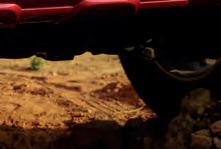
 By PAUL VRIEZE
By PAUL VRIEZE
YANGON — When Ford Motor Company announced at the end of April that it would open an official dealership in Yangon this year, it became the first international car-maker to distribute new vehicles on the Myanmar market, which until recently remained closed off due to international sanctions.
Ford executives said Myanmar’s auto market, although still small, holds great promise for future sales of Ford passenger cars, SUVs and transport vehicles.

Official import figures show that the country’s car sales have grown rapidly since 2011, perhaps by more than 50 percent.
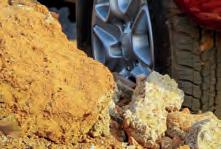




According to analysts and local car dealers, however, demand is volatile











and most consumers prefer secondhand japanese vehicles. They say that it remains to be seen how strong demand for the more expensive new Ford cars will be.
Ford executives said Myanmar offered a new Asian growth market located in an economically vibrant region. “Ford is aggressively expanding its operations in Asia Pacific and Asean. And we saw a great opportunity to expand here in Myanmar,” said Dave Westerman, Asia Pacific regional manager at Ford export and Growth Operations.
“Ford Motor Company will become the first global automaker to provide automotive solutions in Myanmar,” he said at a press conference at Yangon’s Inya
Lake hotel on April 30.
Capital Automotive Group has been contracted to open a Ford facility, comprising a showroom, service center and spare parts warehouse, on Yangon’s Insein road in hlaing Township by the end of this year. The group is a joint venture between Bangkok-based rMA Group and Capital Diamond Star Group, a conglomerate owned by Myanmar businessman U Ko Ko Gyi.
The facility will employ 40 people who will be trained in sales and servicing of Ford cars, said Martyn Dawson of Capital Automotive, adding that sales prices have not yet been set as the firm was still conducting market research.
Mr Westerman said he was confident that brand-new Ford vehicles would be in demand among Myanmar customers, although he stopped short of giving an estimate of how many vehicles Ford could sell here. he added that it was too early to consider investment in car manufacturing and assembling in Myanmar.
“A lot of cars on the roads here are 10, 20 years old, and have no customer warranty, no service,” Mr Westerman said, while Ford would offer “a highquality product and service, and gain a high level of customer satisfaction—this is a critical component of what we bring to Myanmar.”
Ford is among a group of American companies, including Ge, PepsiCo, Coca-Cola and Google, which have announced plans to enter Myanmar after the US government suspended economic sanctions against the country last year following its transition from a military regime to the current quasicivilian government.
“We took a lead off the American government and their call for American businesses to invest here in Myanmar.
Continued on p.44

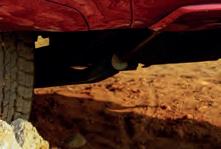



Continued from p.42
And we appreciate the support offered by the American government,” said Mr Westerman at the press conference, which was also attended by US Ambassador Derek Mitchell.
Other international car makers are also eyeing the Myanmar market. Suzuki Motor Corp. announced in October last year that it plans to build a factory in Myanmar by 2015 which would produce 20,000 to 30,000 cars annually. Mitsubishi Motors said in january that it will open three after-sales service centers, while Toyota is reportedly studying vehicle manufacturing in Myanmar.
For now, though, the market is dominated by second-hand car imports from japan, which surged after restrictions on the trade were lifted in October 2011 as part of government reforms. Previously, the Union of Myanmar economic holdings Ltd, a military-owned conglomerate, virtually monopolized the car-import business.
“Between October 2011 and April 24, 2013, a total of 160,431 cars were imported into Myanmar,” U Thein Myint Wai, an assistant director at the Ministry of Commerce wrote in an email.
eric heymann, a senior economist at Deutsche Bank who has researched the Asean auto market, told The Irrawaddy that only 280,000 passenger cars were registered in Myanmar in late 2010, suggesting a 57 percent increase in the number of vehicles over a oneand-a-half year period.
The car market in the impoverished country of about 60 million people is set for a long period of growth, Mr heymann said, as it had less than 10 passenger cars per 1,000 inhabitants, compared to an average of 50 for Asian countries.
A company like Ford would nonetheless have to wait and see how demand for its vehicles will develop. “r ising income (supported by the greater openness of the economy) should support car demand. however, it is difficult to proclaim a certain growth rate for car sales. ‘Young’ car markets, such as Myanmar, typically show high volatilities in growth rates of car sales,” he wrote in an email.
“If [original car makers] are able to raise awareness for their car brands early it is more likely that they benefit from rising car demand,” he said. “There is also probably a small market for luxury cars.”
Local showrooms said Myanmar’s car market had gone through a boom since car import restrictions were lifted in October 2011, but in recent months volatility had entered the market and sales suffered from a fall in demand.
“A lot of people now have a car already and demand is slowing down,” said U Myo han, general manager at Trendy Cars Gallery in Yangon, adding that customers were getting better informed and demanding lower car prices. Most used cars were now being sold at between US $15,000- $22,000, he said.
“Already there are more than 100 showrooms and the prices are going
Such restrictions are a hindrance to business, the showroom owners said, adding that government policy on car imports is overly complicated and subject to constant change.
“We can’t plan which cars to import—last year the government changed their policy four times,” said U Myo han, adding that most car dealers were forced to use individual citizens to import models produced after 2008.
A large car dealer, who declined to be named as his firm was still being registered, said, “All the government departments have relaxed their rules recently, but the Department of Transport is still difficult to deal with,
down. It’s a really tough time, maybe half of us can survive until next year,” he said, adding that sales had halved compared to last year when he sold on average 50 cars per month.

Showrooms have mushroomed across Yangon since 2011, even though government rules only allowed dealers to import models from 1997-2007, which could only be sold in exchange for a registered older car. Since july 2012, Myanmar citizens have been allowed to import cars made after 2008.
like in the old times. Because if it’s difficult [to import cars], you have to pay [them] to get it done quickly.”
Despite such challenges to their business, local showrooms said they were not worried about competition from a new Ford dealership offering brand-new cars on sale in Myanmar.
“All the Myanmar people are used to buying second-hand japanese cars. They don’t buy American cars,” said U Myo han of Trendy Cars Gallery. “If Toyota or honda will come to open a dealership, maybe then it will be difficult for us.”

“ford motor compaNy will become the first global automaker to provide automotive solutioNs iN myaNmar.”
–Dave Westerman, Asia Pacific regional manager at Ford Export and Growth Operations
















Mandalay and Bagan.
Nok Air is owned by Thailand’s state airline Thai Airways. It has stuck to Thai domestic routes since an earlier venture overseas, linking Thailand with India and Vietnam, failed commercially in 2008.
“By staging their flights to Myanmar from cities other than Bangkok, Nok Air hopes to capture the market segments that its arch rival Thai Air Asia cannot,” said The Bangkok Post.
Nok Air is the latest of more than a dozen small and large airlines which have started up regular flights in and out of Myanmar over the past 12 months.
Acquiring one of the 30 offshore oil and gas exploration blocks being offered by the Ministry of energy presents “substantial risks” for foreign investment companies, a business risk assessor said.
Oil and gas production must be shared with local firms, predominantly the state-owned Myanma Oil and Gas enterprise (MOGe).
“Commercial operations of these large state-owned enterprises (Soes) lack transparency, which fosters corruption, nepotism and cronyism,” senior Asia analyst Dr Guo Yu at Maplecroft in the UK told The Irrawaddy.
“In addition, senior members in government and military have vested financial interests in many of the SoEs commanding Myanmar’s resources. As a result, cooperation with local entities in lucrative petroleum exploration holds elevated reputational and complicity risks for foreign oil and gas companies.”
The business advisory comes at the same time as a survey by the US-based revenue Watch Institute placed Myanmar at the bottom of a list of 58 oil- and gas-producing countries in terms of transparency. Myanmar scored lower than notoriously corrupt Turkmenistan, equatorial Guinea and Zimbabwe.
In Myanmar, “almost no information is available on the management of the extractive sector. Myanmar has no freedom of information law, and environmental and social impact assessments are not required,” the institute survey concluded.
Thailand’s tiny airline Nok Air—meaning small bird—intends to offer new routes linking provincial Thai and Myanmar towns.
The airline said it will start services between Mae Sot on the Myanmar-Thai border and Mawlamyine from September.
There will also be flights between Mae Sot and Yangon, and Nok Air said it will link Thailand’s northern capital Chiang Mai with
It’s the third Thai airline to link with Myanmar, a trend helped by the fact that Thais along with Chinese are the biggest nationality groups visiting Myanmar.
A second major global beer company has signed an agreement to build a new brewery in Myanmar in a sector which is moving faster than most other industries as the country opens up.
h eineken of the Netherlands has teamed up with Myanmar’s Alliance Brewery Company to brew and market the heineken brand.
The partnership, which will be dominated by heineken via its Singaporebased Asia Pacific Breweries Limited, said it intends to invest US $60 million and create 400 new jobs in a new brewery. It hopes to begin brewing at the end of 2014.
earlier this year, Carlsberg of Denmark formed a partnership with Myanmar Golden Star Breweries, which has links with the Myanmar military. Carlsberg says its partnership will distribute its brands in Myanmar, but there are
plans also to build a new brewery.
The big Thailand brewing company Thai Beverage is also investing in Myanmar, buying a majority stake in Myanmar Brewery whose other major shareholder is the army-linked Union of Myanmar e conomic holdings.
These companies are banking on Myanmars becoming big beer drinkers as their incomes rise with a growing economy, but at present they are among the region’s most modest drinkers, consuming on average less than four liters per year, compared with per capita annual consumption of 25 liters in Thailand and 30 liters in Vietnam.
One of the most active and rapidly diversifying Myanmar companies, Yoma Strategic h oldings, has moved into household retailing.
Yoma, controlled by businessman Serge Pun, has formed a joint venture with Malaysia’s Parkson r etail Asia to open department stores in Myanmar. The first one, over four stories, has just opened in Yangon.
Yoma is also one of the partners in a joint venture led by Irish-owned Digicel to acquire one of the two mobile telephone network licenses on offer by the Myanmar government. That partnership includes Quantum Strategic Partners, owned by American billionaire speculator George Soros.
e arlier this year, Yoma announced it was forming a partnership with Chindwin holdings Private Limited to develop tourism facilities and services inside Myanmar.
WILLIAM BOOT
The biggest and most colorful collection of telecommunications companies assembled in years is waiting for the decision bell to ring in Naypyitaw in late june on one of the world’s last untapped mobile phone markets.
Twelve international telecom businesses and consortia are on a government shortlist, out of which only two will be awarded contracts to build networks for potentially more than 50 million new telephone customers.

The decision on j une 27 will pave the way to propelling Myanmar into the 21st century, at least in telecommunications terms.
just a few million out of Myanmar’s 50-plus million population have mobile phones and access to an as-yet extremely limited system.
After years of tightly restricted mobile phone ownership through extortionate prices, the government of President U Thein Sein wants wireless telecommunications to be available to up to 80 percent of the population by 2016.
Some of the world’s biggest telephone network companies and some of the most obscure are on the
short list, whittled down from about 90 firms.
They are: China Mobile Limited and Vodafone Group in a partnership; Singapore Telecommunications; Bharti Airtel of India; MTN from Dubai; the Irish-owned Digicel Group; KDDI Corporation of j apan; Sumitomo Corporation, also from j apan; Malaysia’s Axiata Group; Telenor of Norway; Millicom International Cellular of Luxembourg; Qatar Telecom; and Vietnam’s Viettel Group.
The world’s two biggest mobile phone service operators, China Mobile and Vodafone, have 1.14 billion subscribers globally between them. They have teamed up to make the most powerful bid.
But probably the most colorful is the joint venture put together by the small Digicel, which operates mostly among the small Caribbean islands, although it is owned by an entrepreneur from Ireland.
Digicel’s joint venture partners in the license bid are Quantum Strategic Partners, owned by American billionaire speculator George Soros, and Myanmar’s Yoma Strategic holdings, owned by noted r angoon businessman U Serge Pun.
“The challenge for the winners will be recovering the cost of building and maintaining mobile phone networks in one of Asia’s very poorest countries,” said an industry executive with a large Bangkok-based phone company who spoke on condition of anonymity.


“Burmese are just about the lowest paid people in the region and so although the price of SIM cards and phones has become more universally affordable in recent months, the unanswered question is how will these people pay for phone services?”
SIM card prices have plummeted dramatically from US $250 just over a year ago to a mere $1.70 today. But they are not yet widely available. About 350,000 cards were issued in April, many on a lottery basis, and similar numbers will be issued in the coming months.
Can the chosen network franchise holders recoup their investment?
“The opportunity is tremendous, but not without risk,” Nomura Securities’ chief of Asian telecoms Sachin Gupta told Bloomberg. “There are 60 million
users potentially, but that needs a lot of network investment.”
Other foreign telecommunications companies are waiting in the wings to offer ancillary services once the network licenses are issued.
Avaya of the US, which specializes in video conferencing and data networking, has teamed up with local firm First Myanmar, which is also in U Serge Pun’s business stable.
“We believe that we are uniquely positioned to offer affordable firstclass communications to the people of Myanmar and are looking forward to having the opportunity to do so,” Digicel owner Denis O’Brien told the Irish Independent, which he also owns.
Unlike some of the other bidders which have kept a low profile as they quietly lobby behind the scenes to promote their credentials to government ministers and officials, Digicel has pursued a high-profile public image in support of their bid.
The j amaica-based firm, ranked only 65th in customer size in the global telecoms market, has been sponsoring Myanmar sport, promoting brand awareness among Myanmars who don’t yet even have a phone, and surveying sites for transmission aerials across the country.
“The low mobile penetration rate in [Myanmar] presents a significant opportunity for telecoms firms, but the Digicel consortium will face some stiff competition for licenses,” commented the Irish Independent newspaper, pointing out that Mr O’Brien’s telecommunications forays into the Caribbean islands in the past 10 years have made his fortune.
Not bad for someone who started out on his business career selling horse medicines for his father.
The Digicel joint venture is up against the might of the world’s biggest mobile phone service operator, China Mobile, a state-owned enterprise with 97 percent of the colossal Chinese market and over 700 million customers. But perhaps the recent backlash against China’s strong business influence in Myanmar will influence bid decisionmaking.
Come june 27 we’ll know whether Mr O’Brien’s background impressed the Naypyitaw government more than the stolid, faceless managers of China Mobile.
against the expansionist British in the 19th century and lost each time, culminating with the ignominious dissolution of the Burmese monarchy in 1885. e ach Burmese defeat partly enticed the Siamese to make concessions to the British, capped by the transfer of northern Malay states to Britain in 1909. After Britain annexed Burma, the Siamese also made concessions to French imperialists who were pressing from Indochina. In 1893, the French gained much of what is Laos and Cambodia today. Such is the close historical parallel between Burma and Siam—between a warrior culture that could not withstand Western imperialist forces, and a culture of slippery but pragmatic Siamese that survived.
By THITINAN PONGSUDHIRAKOne of the myriad fusses in official Thai history focuses on Siamese independence in December 1767 after its capital Ayutthaya had been sacked by converging Burmese armies seven months earlier. It is said that the reclamation of independence was attributable to King Taksin’s uncommon valor and extraordinary skill in military leadership, strategy and organization. While this story carries half of the truth, it is an anecdotal illustration of two ancient rival empires and deep-seated foes whose future directions are as entwined as their recent pasts have diverged. With the contrasting fate and fortune of ancient Burma and Siam, Myanmar and Thailand must now find ways to work and grow together for mutual benefit in the 21st century.
The King Taksin tale in Thai history conveniently omits the fact that Ava, Burma’s capital at the time, was being besieged by Chinese hordes who had invaded from the north. Instead of recalling his armies back immediately to defend the capital, King hsinbyushin held off the Chinese while telling his commanding generals to finish the job in Siam. They did. The onceglorious Ayutthaya Kingdom ended
then and there. The Burmese armies then managed to return and beat back the Chinese invaders, leaving only a small garrison at Ayutthaya that was subsequently routed by Taksin, whose kingship lasted just 15 years before the current Chakri Dynasty took over and reigned to this day.
Along the historical narrative of war and conquest between Burma and Siam, the Burmese mostly had the upper hand vis-à-vis the Siamese. Only during a brief period in the early 17th century, under their most ingenious military strategist King Naresuan, did the Siamese take the battle into central Burma. For much of the competing empire years, it was the Burmese who went on the march. Burma was fundamentally a warrior state, whereas Siam was quintessentially a trading nation. One kingdom was wholly preoccupied with war and conquest, the other mainly with trade and commerce. Mixed with geographical location and terrain and the course of history, these DNA strands in their respective peoples, lands and nationhood explain where Thailand and Myanmar stand today.
Geography was decisive. Burma was next to British India. Being a warrior race, the Burmese fought three wars
The intervening 20th century also blew different storms towards the two nations. Burma eventually regained independence and became a thriving democracy in the 1950s before an autarkic military rule set in by 1962. After a quarter century of insularity, it opened up again in fits and starts, now beset by baggage from its past. Myanmar’s unruly ethnic composition and mountainous terrain have posed challenges for governance and stability. Its suppressed superiority complex may now be at the heart of the widening religious and sectarian violence after the political openings and reforms that began in 2011.
By contrast, Thailand, as Siam was called after 1939, over much of the same period from 1957 to 1988 harbored military regimes that were open to business, trade and investment, perhaps because of its lack of colonization and its proclivity for trade and commerce. The generals empowered development technocrats to run the economy, laying the groundwork for four decades of relative economic prosperity. The long boom spawned growing middle classes that promoted gradual democratization. But it was too intense and its fruits were too concentrated in the upper and middle classes and did not sufficiently cascade down to the lower rungs. Thailand’s social inequalities and economic disparities over time were later exploited by Thaksin Shinawatra. And Thailand has been stuck in a holding pattern since its 2006 military coup. Mr Thaksin’s forces have won all elections since 2001 but are unable to rule and lead resolutely, whereas his
After centuries as foes, Myanmar and Thailand are now on a similar course and share common regional goals
adversaries can stymie and stonewall to keep Mr Thaksin at bay but cannot win once at the polls.

After Burma’s and Siam’s paths diverged over a century ago, Myanmar and Thailand have reconnected in a new orbit of the 21st century. Thailand now relies on Myanmar for much of its gas supply (its main source of electricity generation), labor force and security needs, such as drugs suppression. Without Myanmar, Thailand would face power blackouts and skyrocketing wages. For its part, Myanmar has shelved its nuclear weapons program, and has gained from
bilateral trade and development with Myanmar. The same consensus, for example, does not hold with Thai policy towards Cambodia.
The current big deal in MyanmarThai relations is the Dawei megaproject. What both sides must do is take a long-term view and avoid myopic parochial interests. The multibillion-dollar deal began in 2008 when Thai construction conglomerate Ital-Thai Development was awarded a concession to develop 250 square kilometers centering on Dawei. As the project languished, the Yingluck government has shouldered the burden

vested economic and business interests in mind.
More broadly, Thailand is Myanmar’s corridor to the Association of Southeast Asian Nations (Asean), and Myanmar’s awakened presence has turned mainland Southeast Asia into a beckoning and burgeoning region that will only expand in GDP terms. The combined consumer market of Cambodia, Laos, Myanmar and Thailand, along with connected links to Vietnam, Yunnan and Malaysia, exceeds 350 million, underpinned by abundant natural resources and growing transport and communications connectivity. The economies of this region are set to grow on their own, overlapping with some of the promises of the Asean Community after 2015. The challenge will be politics, big and small.
The big politics will be how to keep a major-powers balance in mainland Southeast Asia, leveraging the United States, japan and Asean on the one hand and China on the other. This region is China’s natural sphere of influence but it must be kept in check by other major powers to ensure that regional interests are kept in a workable and mutually beneficial mix. No major power should be allowed to dominate mainland Southeast Asia. Myanmar and Thailand can leverage the other major players to achieve this objective.
workers’ remittances, as well as aid, loans, investment deals and capacitybuilding programs from Thailand. The Bank of Thailand, for example, assisted with the recent float of the kyat.
Thailand also no longer officially supports the hitherto “buffer” policy of aiding, abetting and sheltering ethnic minorities, such as the Shan and the Kayin, who have battled against the Tatmadaw. In fact, there is now a consensus in Thailand over its Myanmar policy. All Thai governments, whether under the current Prime Minister Yingluck Shinawatra or the opposing former Prime Minister Abhisit Vejjajiva in 2008-11, have pursued cooperation and collaboration on all matters of
and appears poised to undertake some investments with public funds for ITD’s private benefit.
In addition, Mr Thaksin lurks in the background as he has reportedly expressed investment interests in relation to the project. Myanmar’s authorities would do well not to repeat Cambodia’s mistake by taking sides in Thailand’s deeply divided society. Myanmar’s dealings with Thailand should be multifaceted and inclusive with all major stakeholders. The same goes the other way. Thailand’s government should extend goodwill gestures and deal with Myanmar’s principal stakeholders in a comprehensive fashion, and not favor any particular party or faction with
The small politics will be within. Notwithstanding shortcomings and setbacks, Myanmar’s democratic development must remain on track, while Thai democracy must consolidate and entrench beyond elections. In both countries, democratic institutions to promote checks-and-balances, participation, and transparency and accountability are imperative. Myanmar and Thailand may be at different stages on different roads, but their ultimate destinations are so close that it is now in both countries’ interests to embrace each other with the same energy with which they once fought.
Thitinan Pongsudhirak teaches international political economy and directs the Institute of Security and International Studies at the faculty of political science, Chulalongkorn University.


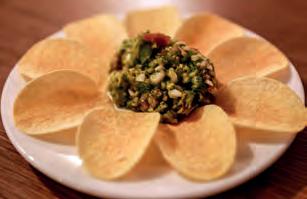

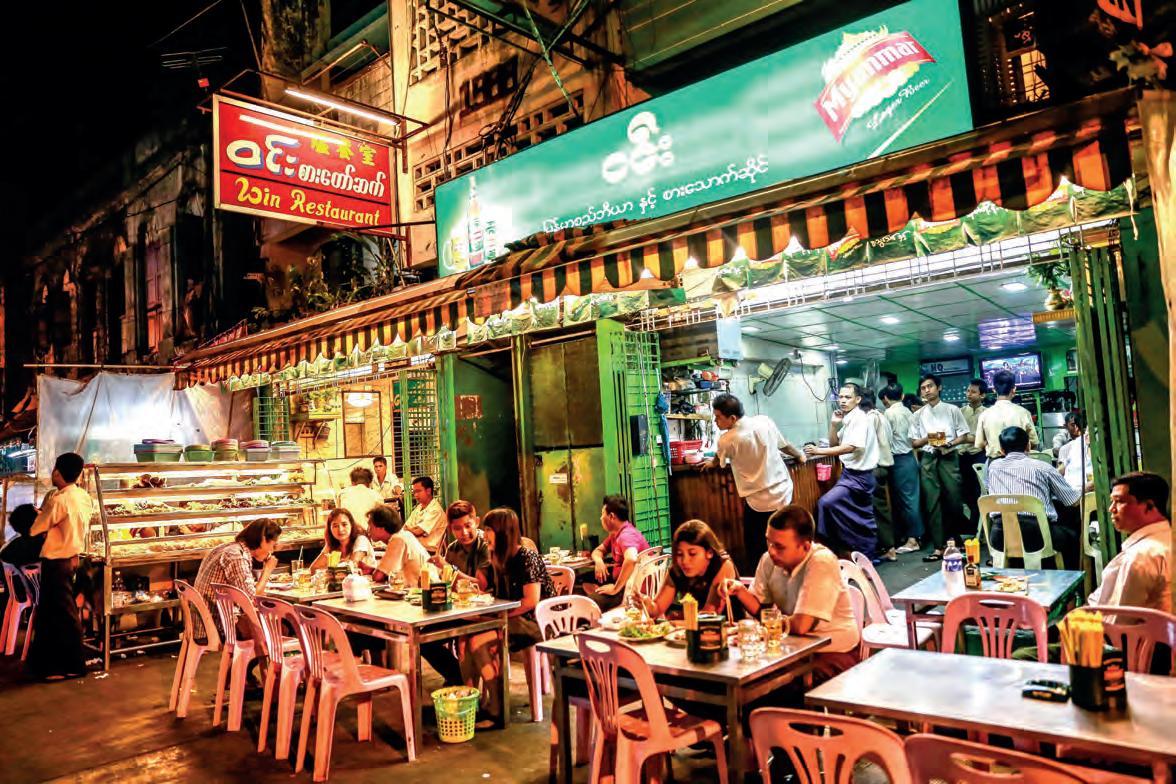 By PATRICK BOEHLER
By PATRICK BOEHLER
Out of sight of most tourists’ cursory visits, Yangon’s Chinatown is where Myanmar meets its massive neighbor to the north, hundreds of kilometers from their nearest border crossing. As a cultural meeting place in the heart of Myanmar’s largest city, it is also, among other things, a culinary treasure-trove.
every afternoon, hawkers with garlic fried chili crabs, steamed dim sum and straw baskets full of strawberries set up their shop
around the Guanyin temple, bracing themselves for the onrush of evening strollers.
By the time the sidewalk spills into the street, the butcher at Good Diamond Sausages has sold out his daily output of pork sausages he says are made according to a recipe brought over from Guangdong in the 1940s. “They’re just a bit less sweet than in hong Kong,” he says.
Most of Yangon’s Chinese population of about 150,000 still live in the area and most use Myanmar

names and resort to the Myanmar language in their conversations. Men wear traditional longyi gowns and many waiters at Chinese restaurants are Myanmars. After decades of fearing a re-eruption of racial tensions, Yangon’s Chinese make a point of being Myanmar first, Chinese second.


Old, and some very new, wire fences around first and second floor windows show that concerns over longsimmering ethnic hatred haven’t faded.
Discovering how they preserve their heritage is becoming less of challenge. Chinese is once again the language to learn, and many young people speak crisp Putonghua along with the Cantonese, hokkien or Fukkien dialects of their grandparents. The two bookstores that have Chinese books have put their money in schoolbooks; copycat DVDs of Chinese television series are sold near the Guanyin temple.
The foods that can be found on the streets of Chinatown are the strongest statement of a unique Chinese identity in Myanmar’s largest and most ethnically mixed city.

The Liangtai Lashio Broken Crisp Buns restaurant on Latha Street, opposite the more crowded Cherry Crown restaurant serving cold Myanmar Beer and Myanmar food, has the typical culinary compromise that makes Yangon’s Chinatown unique.
Steamed filled rice dumplings (200 kyat) are served cut into slices along with the typical Myanmar chili-tomato sauce wrongly called ketchup. The sweet buns with their savory fillings come with strong Myanmar black tea (200 kyat) made sweet and heavy by condensed milk.
Liangtai’s red and pink plastic stools are separated from traffic by a row of wooden deck chairs, where businessmen stop by for an hourly foot massage (4000 kyat), a cigarette (50 kyat) and a chat.
Angshandu, on a side street cornering to Guanyin temple, has Guangdong food with a Myanmar twist. Char siu pork comes with a spicy, peppery sauce and chicken broth. Stewed pork
comes with chives and fragrant mushrooms. Hundun dumplings are either served in soup or cold in a bowl with shredded chicken or pork and crispy fried garlic.



On the other corner of the temple, rice porridge (500 kyat) is cooked every day in giant metal pots on carts. A bowl comes with fresh steamed blood, liver, fried garlic and chives. The zongzi, pyramid-shaped portions of steamed sticky rice with pork or chicken, sold wrapped in banana leaves and hanging from metal rods, (1,000 kyat) are a traditional dish eaten for the Dragonboat Festival on the fifth day of the fifth lunar month.
Nearby, elderly Ms jiang sits on a stool selling bright red and white sticky rice dough filled with sweet red bean paste or crushed peanuts. She also sells “tea cake,” an adapted version of Cantonese niangao sticky rice cake made with eggs and coconut milk. With a chop she has branded her shop’s calligraphic name on the sticky deserts.
By the time the stands are up outside Guanyin temple, the fortuneteller inside the temple has gone home for the day and young novice Buddhist monks play in its courtyard. 19th Street, just around the corner, will start filling up with tourists and locals coming for cheap beer and Yunnan-style barbecue.
Most of those expats who have been around a while end up at Kosan, not for the average food, but for the their Mandalay mojitos (800 kyat) made with Mandalay rum, and to sit at their underappreciated balcony, which looks down on the steaming pots and grills that feed the increasing stream of travellers to the once sleepy street.
The balcony looks down on the street in which, some 50 years ago, the Chinese embassy distributed little red books in a long-since forgotten effort to spread the Great Proletarian Cultural revolution abroad.
New Chinese migrants settle around town. With soaring land prices, new immigrants seek their fortune in the suburbs, where land is affordable and shops are still few. Yangon’s Chinatown is the home of those who ventured to Myanmar when it was a different place.

Pansodan Art Gallery in downtown Yangon is much more than a showroom for paintings. The gallery’s owner, 42-year-old arts patron Aung Soe Min, says he and his partner Nance Cunningham opened the gallery in 2008 to showcase the work of local artists, but he has been amassing his impressive collection of cultural artifacts—from book covers and postcards to movie posters and propaganda art—for so long that he now has enough to fill four more houses. During a recent tour of the gallery, he spoke to Irrawaddy reporter Samantha Michaels about his treasures, how censorship affected his business during the era of military rule, and why he wants to create a visual account of Myanmar’s long-shrouded past.

I have propaganda art, ads, artwork from book covers—much of the collection is extremely rare. Let me show you some of them. here are movie posters from before the Second World War, before TV was around. I have rare photos, including some historical ones, like this one of the prime minister from the independence era, or a group photo here with Daw Aung San Suu Kyi’s mother. These book covers are from before World War II. They show the beginnings of modern fashion here, local fashion in Yangon. You can see some are in the style of Western pin-up magazines. here you can see a photo of the 1947 Panglong Conference, the most famous conference, and here’s the first president of Myanmar. I also have historical documents.
Where do you find these things?
We just started collecting. People come and sell what they have, and I sort through them slowly. Sometimes if famous artists or politicians pass away and their families can’t keep all their things, I’ll go out and see if they want to sell. I always encourage them to keep it, but if they don’t want it, I collect. People keep these things in their homes for a time but have no system to organize them, like me. It’s very difficult to maintain them, in fact.
In the beginning I just started collecting for my private interest, but later I started thinking more for future history and research. I want to get an alternative history. everything we’re learning is just the standard history from the government, and nobody is doing research properly yet in many fields—history, literature, the media. We can do a history of newspapers properly, or even a history of comic books—I collect comic books, too.
Some of these things are very rare, and if it’s one of a kind,
it’s important for history and we don’t sell. These things are mostly for researchers. But if we have extra, then we sell.
The government’s censorship board was disbanded this year, but it was still around when you opened the gallery in 2008. How did that affect business?
We had to invite the censorship board before exhibit openings. They would come and decide which paintings we couldn’t show. Censorship limited what artists could create, so that was always a problem. But for us, really, the censors didn’t pay that much attention to the art. They thought of

An arts patron in Yangon pieces together an impressive visual account of Myanmar’s past
art as something that just hangs on a wall in your home, rather than being public, so they didn’t pay much attention. Artists were a little less oppressed than writers, filmmakers or musicians, whose works were more publicized.


Do you have a favorite artist or writer?
Many. I really like [Yasunari] Kawabata, a japanese writer who won a Nobel Prize, and also rabindranath Tagore, a Bengali writer and poet. As for contemporary writers, I also like Thomas Pynchon’s “Gravity’s rainbow.” I have several favorite artists, like Paul Klee, [Wassily] Kandinsky and [joan] Miro.

Myanmar’s once most feared spy chief U Khin Nyunt has opened an art gallery and coffee shop at his leafy Yangon residence, where he also spent several years as a prisoner of the previous regime. In May the former prime minister began welcoming members of the public into a beautiful eden-like garden area with fruit trees, rare flowers and a space where artists can exhibit their work.
“I feel peace now, but I wanted to experience it more,” the one-time spymaster told The Irrawaddy. U Khin Nyunt was accused of gross human rights abuses during his time in government, but now that he’s out of office he’s trying to find some zen—by getting in touch with his artistic side.
U Khin Nyunt has had numerous visitors—mostly elderly Myanmars—to his “Nawaday Art Gallery” since he opened it to the public in mid-May.
In an exclusive interview with The Irrawaddy, he said he wanted to bring peace to his life by helping others, including Myanmar artists.

“There are people who are good painters,” he said. “I wanted to help them. They can exhibit their work here without charge.
“A lot of tourists are visiting our country now as we have political change,” he continued. “This will be a place where tourists can come and buy good paintings, or I will help our Myanmar artists to export their work and sell it to foreign countries.”
Ironically, under U Khin Nyunt’s secret police department many artists were imprisoned under highly restrictive censorship regulations. Few would have predicted U Khin Nyunt’s new incarnation as a gallery owner with a love of art and a desire to support local artists.

 Artist Aung Myin Baw
Artist Aung Myin Baw
 By Steve Tickner
By Steve Tickner
Two photographers have embarked on a Myanmar book project documenting the crumbling British colonialera architecture for which Yangon is rightfully renowned.
Moroccan-born Australian jacques Maudy and Italian jimi Cassaccia manage to depict a time-warp metropolis through their striking pictures while also sending a serious historical preservation message.
Their book, “Yangon: A City to rescue,” was released as a 60-page hardcover on April 22 during a launch at the Australian embassy.
The body of work, taken on behalf of the Yangon heritage Trust, founded by prominent Myanmar historian U Thant Myint U, offers quality imagery and fine detail in saturated color with a special feel for the monsoonal mood of the former capital.

The work is part of a collective effort by historians to enact legislation to protect this valuable aspect of the city’s culture for generations to come.
The trust received a significant boost when Australian Foreign Minister Bob Carr visited Yangon in june and pledged his government’s support and expertise to help
protect the nation’s rich architectural heritage.
There is deep concern that with the recent easing of economic sanctions, a drive for development may pose a serious threat to the significant yet fast-decaying examples of 19th century design. Many buildings are in need of serious restoration after years of neglect.
Already, as a direct result of the trust’s work, the government has reportedly suspended 20 building permits until the subject of conservation can be clarified.

Mr Maudy and Mr Cassaccia have made the best possible use of Yangon’s dank and overcast climate to soften shadows and bring out excellent details of the heritage buildings in arresting color. In addition, there are many fine
examples of portraiture and Yangon street scenes.
The photo book includes special sections for the Pegu Club, the Secretariat and the Shwedagon Pagoda.
The ancient Shwedagon Pagoda forms the cultural heart of Yangon, and at a height of 110 meters it towers over the surrounding parks and monasteries. The photographers captured visiting Buddhist worshippers and the intricate complex and its gilded spires against the backdrop of Yangon’s overcast skies.
The exclusive Pegu Club of colonial times was built in the late 1880s of top quality teak, and although now in serious disrepair, it has withstood the test of time remarkably well. The club was in its heyday both elitist and racist, with even the highest ranking Myanmar nationals banned from admittance.
A number of exterior and interior photos highlight the iconic Yangon Secretariat building. This is where Bogyoke Aung San, Myanmar’s independence hero and father of current democracy icon Daw Aung San Suu Kyi, was murdered by a political rival in 1947.
Since the time of his assassination the building has been closed to outsiders, so these images give a rare glimpse into a significant period of Myanmar history.
Embracing Myanmar’s political opening, The Irrawaddy magazine has returned to the country after 20 years in exile. With the establishment of our new office in Yangon, The Irrawaddy’s journalists are now back in their homeland to report on the amazing things happening here.

Over the past two decades, The Irrawaddy has made a name for itself as one of the leading publications on Myanmar for in-depth and reliable news, information and analysis going to international audiences.


Our coverage and analysis of Myanmar, Thailand and Southeast Asia has been cited in the New York Times, the Washington Post, the Guardian, Foreign Policy, Der Spiegel, BBC, CNN, Al Jazeera and major regional newspapers.
We are happy to be home and to continue to serve you with our independent journalism.
Yangon Bureau MyanmarRegional Office
Chiang Mai, Thailand
